Aboriginal
Aboriginal Definition
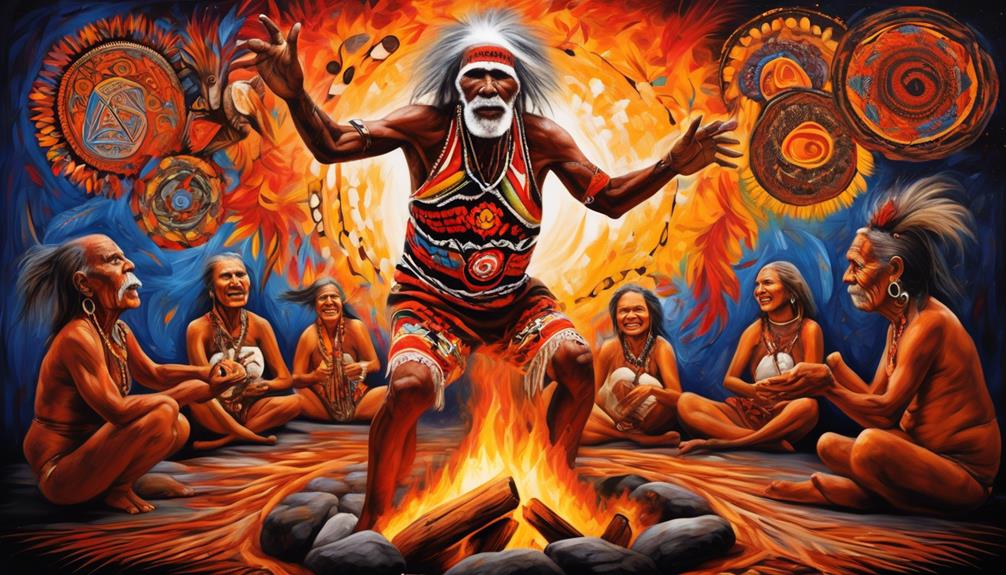
We have all encountered situations where the term ‘aboriginal’ has sparked discussions and deep reflection. Whether regarding issues of land ownership, cultural identity, or official recognition, the concept of being aboriginal is complex and multi-faceted.
It's a term that carries significant weight and has far-reaching implications, not only for indigenous communities but also for national and international policies and perspectives. As we navigate through the intricacies of this definition, we begin to unravel the layers of history, identity, and the ongoing struggle for acknowledgment.
Key Takeaways
- Legal definitions of Indigenous identity vary between jurisdictions, resulting in inconsistencies and inequities.
- Advocating for inclusive legal definitions safeguards the rights and traditions of Indigenous communities.
- Global recognition of Indigenous rights is essential for acknowledging injustices and promoting justice and equality.
- Calls for restoration of autonomy and self-governance, protection of cultural heritage and sacred lands.
Historical Context
Examining the historical context reveals the complex and often tumultuous interactions between Aboriginal communities and colonial powers. The impact of colonialism on Aboriginal communities has been profound, leading to historical injustices that continue to reverberate through society today. Throughout history, Aboriginal communities have displayed remarkable resilience in the face of cultural oppression and forced assimilation. The preservation of their cultural heritage has been a source of strength and identity, contributing to the rich tapestry of human diversity.
The societal impact of historical injustices on Aboriginal communities can't be overstated. The legacy of colonization has resulted in systemic inequalities, disenfranchisement, and marginalization. However, despite these challenges, Aboriginal communities have demonstrated remarkable strength and resilience. Their ability to endure and overcome the trials of history speaks to the depth of their cultural roots and the power of community solidarity.
The struggle for cultural preservation has been intertwined with the broader fight for social justice and equality. The resilience of Aboriginal communities in the face of historical injustices serves as a testament to the enduring spirit of a people who've faced centuries of adversity. By understanding this historical context, we gain insight into the ongoing struggles and triumphs of Aboriginal communities, and we can work towards a more just and equitable future for all.
Indigenous Identity
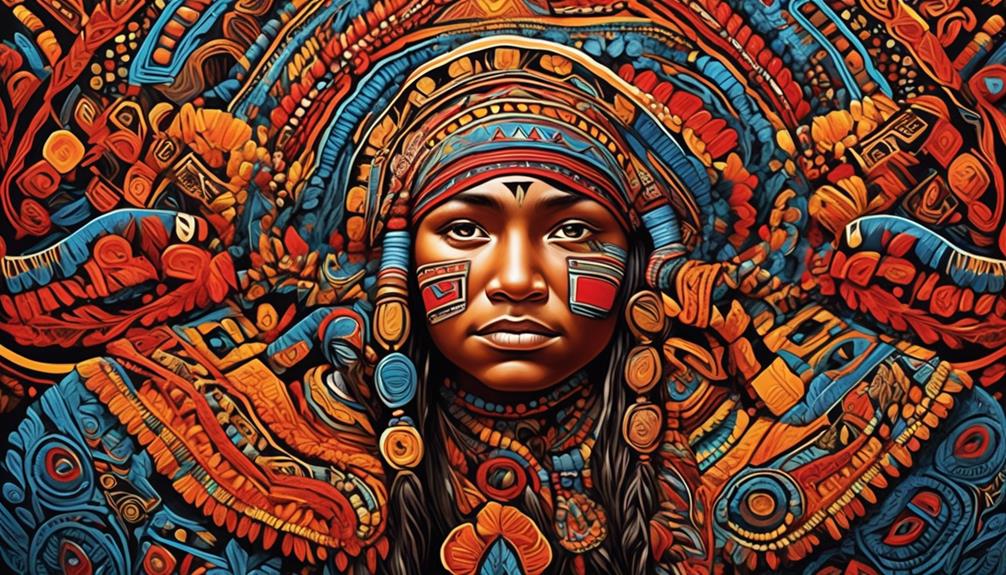
Indigenous identity is an integral part of the cultural tapestry that enriches our society, embodying a profound connection to history, heritage, and community. It is the thread that weaves together the diverse experiences and perspectives of Indigenous peoples, shaping their unique place in the world. When we consider Indigenous representation, it becomes apparent that the portrayal of Indigenous identity in media and popular culture often lacks authenticity and depth. This misrepresentation perpetuates harmful stereotypes and erases the rich tapestry of Indigenous cultures. On the other hand, initiatives that prioritize authentic Indigenous representation empower communities and foster understanding and respect.
| Challenges | Solutions |
|---|---|
| Misrepresentation in media | Authentic storytelling and diverse representation |
| Cultural appropriation | Collaboration and consent with Indigenous communities |
Cultural preservation is another essential aspect of Indigenous identity. The preservation of traditional practices, languages, and knowledge systems is crucial for maintaining the integrity and resilience of Indigenous cultures. Efforts to support cultural preservation, such as language revitalization programs and the protection of sacred sites, are vital for upholding the rich heritage of Indigenous peoples. Embracing Indigenous identity not only enriches our collective cultural landscape but also serves as a powerful reminder of the importance of respecting and nurturing diverse cultural expressions.
Legal Definitions
When considering legal definitions of Indigenous identity, it's essential to recognize the intricacies and implications embedded within the framework of such definitions. Legal definitions play a crucial role in determining an individual's access to their legal rights and cultural preservation.
As we delve into the realm of legal definitions, it becomes evident that:
- Legal definitions can vary widely between different jurisdictions, which can result in inconsistencies and inequities in the recognition of Indigenous identity and rights.
- The legal framework often imposes specific criteria for Indigenous identity, which may not align with the diverse cultural and historical experiences of Indigenous peoples.
- Legal definitions have the power to shape the allocation of resources and access to services for Indigenous communities, making it vital to critically examine and challenge restrictive definitions.
- The intersection of traditional customs and modern legal systems can create complexities in defining Indigenous identity within a legal context, leading to the potential erosion of cultural preservation and heritage.
Navigating the legal landscape surrounding Indigenous identity is essential for safeguarding the rights and traditions of Indigenous communities. By advocating for broader and more inclusive legal definitions, we can strive towards a future where Indigenous peoples have the autonomy to define and preserve their cultural identities in accordance with their own diverse histories and traditions.
Cultural Diversity
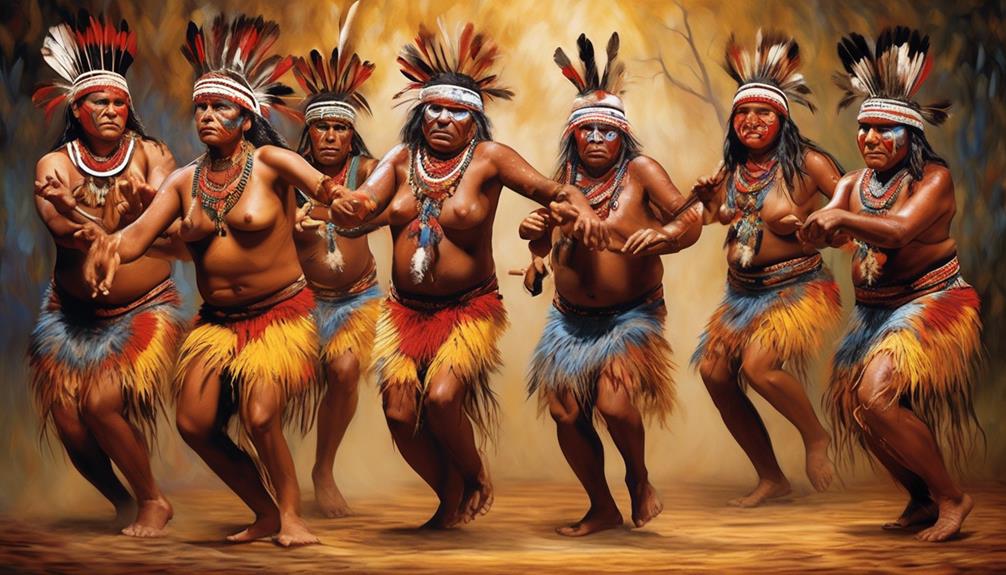
As we embrace the topic of cultural diversity within Aboriginal communities, it becomes evident that traditional practices, language, and art play a significant role in shaping the identity of each group.
Comparing the various practices and art forms across different Aboriginal communities offers a rich tapestry of cultural expression and heritage.
Contextually, the preservation of language and traditional practices reflects the resilience and richness of Aboriginal cultures across different regions.
Traditional Practices
Drawing on centuries-old customs and rituals, the Aboriginal community preserves and passes down traditional practices that reflect their cultural diversity. These practices aren't only a means of cultural preservation but also embody sustainable living, creating a harmonious relationship with the environment.
The intergenerational knowledge transfer within the community ensures that these traditions remain vibrant and relevant, fostering a deep sense of connection to their ancestors and the land.
Community engagement plays a pivotal role in upholding these traditional practices, allowing for the exchange of ideas and the celebration of diverse customs.
Through traditional practices, the Aboriginal community showcases a profound understanding of the interconnectedness of all living things, offering valuable insights into sustainable living for the benefit of present and future generations.
Language and Art
Preserving and passing down traditional practices that reflect our cultural diversity, the Aboriginal community also cherishes its language and art as integral components of our rich heritage.
Language preservation is paramount, as it holds the essence of our identity, encapsulating millennia of wisdom and knowledge.
Our traditional storytelling, conveyed through oral traditions and now in written form, serves as a profound link to our history, values, and spirituality.
Indigenous artwork, with its vibrant colors and intricate designs, not only captivates the eye but also carries deep cultural symbolism, conveying stories of creation, connection to the land, and ancestral knowledge.
Through language and art, we continue to celebrate and perpetuate our cultural diversity, ensuring that our heritage remains alive and thriving, a testament to our enduring spirit and resilience.
Global Perspectives
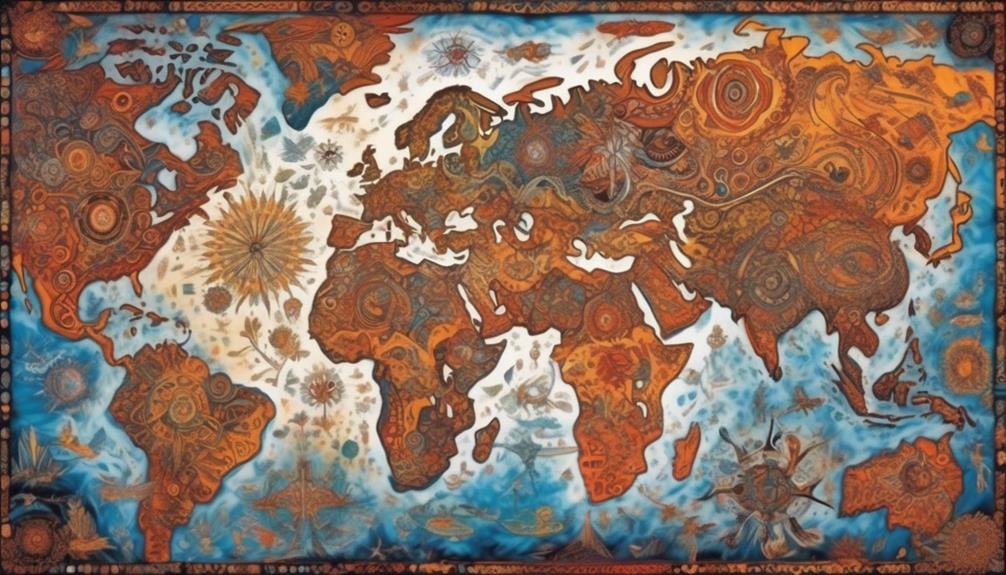
From our global perspective, the traditional practices and cultural significance of the Aboriginal people offer valuable insights into the interconnectedness of humanity and the natural world.
- Indigenous perspectives emphasize the deep connection between humans and the environment, recognizing the importance of living in harmony with nature. This worldview challenges the dominant Western perspective and offers a holistic approach to understanding our place in the world.
- Cultural preservation is central to Aboriginal communities, serving as a reminder of the rich tapestry of human existence and the diversity of cultural expressions. This preservation is a testament to the resilience and determination of indigenous peoples in the face of historical oppression and ongoing challenges.
- Global recognition of indigenous rights is an essential step towards acknowledging the injustices that have been perpetrated against Aboriginal communities worldwide. It calls for the restoration of autonomy and self-governance, as well as the protection of cultural heritage and sacred lands.
- The Aboriginal experience provides a lens through which we can critically examine our own societal structures and values, prompting us to question the impact of globalization and modernization on indigenous communities. This critical reflection encourages a reevaluation of our relationship with the natural world and the ways in which we interact with diverse cultures and traditions.
Traditional Territories

As we explore the concept of traditional territories, we see the intricate connection between land ownership rights, cultural significance, and resource management.
In many indigenous communities, the land holds deep spiritual and historical importance, shaping their identity and way of life.
Understanding these traditional territories is crucial for respecting and preserving indigenous cultures and fostering meaningful relationships with these communities.
Land Ownership Rights
The traditional territories of Aboriginal communities are fundamental to their cultural identity and sustenance, serving as the foundation for their land ownership rights. Our connection to the land goes beyond legal ownership; it's deeply rooted in our heritage and spirituality.
- Land rights aren't just about possession but about sovereignty, acknowledging our inherent authority over our territories.
- Indigenous perspectives on land ownership prioritize stewardship and sustainability, viewing the land as a living entity that must be preserved for future generations.
- Conservation efforts are guided by traditional ecological knowledge, recognizing the interconnectedness of all living beings and the land.
- Our struggle for land rights is a fight for self-determination and the ability to govern our territories in ways that align with our values and traditions.
Cultural Significance
Deeply embedded in our cultural heritage, our traditional territories hold profound significance, shaping our identity and way of life. These territories are not just physical spaces; they are the embodiment of our history, spirituality, and interconnectedness with the land. The table below illustrates the diverse cultural significance of traditional territories for different Aboriginal communities, highlighting the importance of cultural preservation and community empowerment.
| Aboriginal Community | Cultural Significance | Community Empowerment |
|---|---|---|
| First Nation | Ancestral connection, sacred sites, hunting grounds | Land management, cultural education, self-governance |
| Inuit | Ice and snow traditions, survival skills, storytelling | Co-management agreements, language revitalization, art |
| Métis | Bison hunting, fiddle music, Red River cart | Cultural tourism, economic development, political advocacy |
Understanding the multifaceted significance of traditional territories is crucial for fostering cultural preservation and community empowerment.
Resource Management
Embedded in the cultural significance of traditional territories is the crucial aspect of resource management, which plays a vital role in sustaining our communities and preserving our heritage.
Traditional practices, land management, resource conservation, and sustainability practices are integral to our resource management. Our traditional practices are deeply rooted in the sustainable use of natural resources, ensuring that we maintain a delicate balance with the environment.
Land management involves not only utilizing the resources but also preserving the land for future generations. Resource conservation is a priority, and we employ various methods to ensure the sustainability of our resources.
Our sustainability practices are based on the understanding that the health of our communities is intricately linked to the health of our traditional territories, and we strive to manage our resources in a manner that reflects this interconnectedness.
Self-Government Rights

Although some Indigenous groups have achieved self-government rights, many are still working towards securing this essential autonomy. The ability to govern ourselves and make decisions that directly impact our communities is a fundamental aspect of self-determination. For some Indigenous communities, self-government rights have provided the opportunity to develop governance structures that are more reflective of our cultural values and traditions, leading to increased community empowerment. However, there are still many challenges and barriers that prevent other Indigenous groups from fully exercising their right to self-government.
| Challenges | Opportunities |
|---|---|
| Limited funding for self-governing Indigenous communities | Greater control over resource allocation and management |
| Inadequate political representation at higher levels of government | Ability to enact laws and policies that align with cultural values and traditions |
| Complex negotiations with federal and provincial governments | Increased autonomy and decision-making power within our communities |
The disparity in the implementation of self-government rights among Indigenous groups highlights the need for ongoing advocacy and support for all communities seeking self-determination. It is crucial to address the systemic barriers that hinder the full realization of self-government rights and to ensure that all Indigenous peoples have the opportunity to govern themselves in a manner that honors their unique cultural identities. The journey towards self-government is an essential part of the broader struggle for liberation and sovereignty.
Colonial Impact
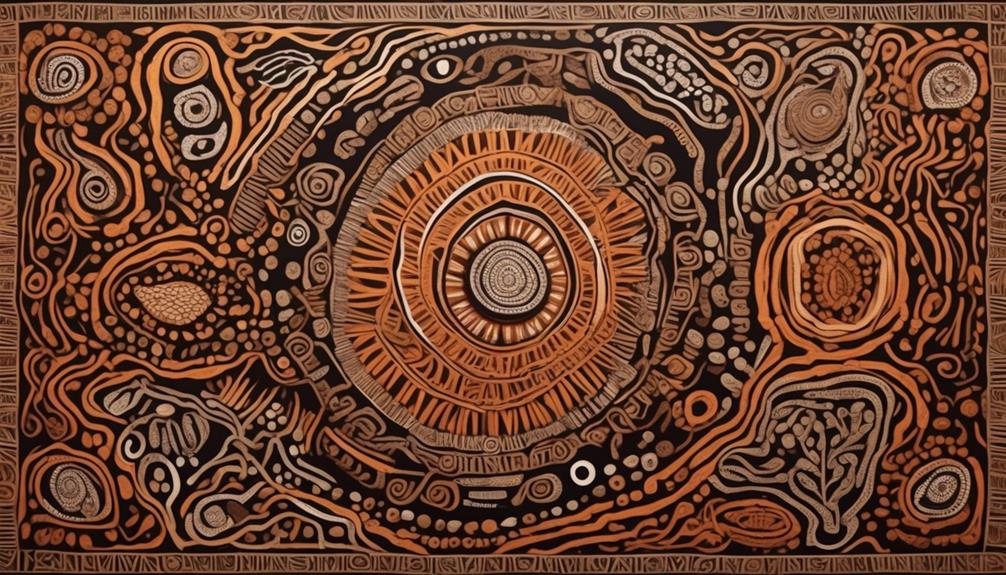
As we examine the colonial impact on Aboriginal communities, it becomes evident that the historical oppression and cultural erasure have had lasting and profound effects.
The comparison between the pre-colonial and post-colonial eras highlights the stark contrast in the autonomy and cultural preservation of Indigenous peoples.
The contextual understanding of colonial impact is crucial in recognizing the ongoing struggles and resilience of Aboriginal communities in the face of historical injustices.
Colonial Oppression
During the colonial period, the indigenous peoples experienced systematic oppression and dispossession of their lands and resources. This had profound psychological impacts, leading to intergenerational trauma that continues to affect our communities today.
The resilience of our ancestors is evident in the resistance movements and cultural revival that have emerged, serving as a source of strength and inspiration for our ongoing struggle for justice and liberation.
Despite the enduring effects of colonial oppression, we've persevered and revitalized our traditions, languages, and spiritual practices. The legacy of colonialism is a painful reality, but it has also sparked a powerful reclamation of identity and a renaissance of indigenous knowledge and pride.
Our journey toward healing and empowerment is a testament to the indomitable spirit of our people.
Cultural Erasure
Amidst the colonial impact, our cultural heritage has been systematically erased, leaving deep wounds that continue to shape our communities today. The intentional erasure of our traditions, languages, and belief systems has led to a loss of identity and belonging.
Cultural assimilation policies enforced by colonial powers sought to eradicate our way of life, leaving a legacy of trauma and disconnection from our roots. Despite these challenges, there's a growing movement towards cultural preservation and revival. Our communities are reclaiming traditional practices, revitalizing languages, and fostering cultural resurgence.
This revival isn't just about the past; it's a powerful act of resistance and resilience, shaping a future where our cultural heritage is celebrated and woven into the fabric of our existence. This journey of reclaiming our cultural identity is a fundamental part of our liberation.
Contemporary Challenges

One of the most pressing contemporary challenges facing Aboriginal communities is the preservation of traditional languages and cultural practices in the face of modernization and globalization. This challenge is complex and multifaceted, impacting the very essence of Aboriginal identity and heritage. As we navigate this critical issue, several key factors come into play:
- Language Revitalization: Many Aboriginal languages are at risk of extinction as fluent speakers decrease in number. Efforts to preserve and revitalize these languages are crucial to maintaining cultural heritage and knowledge.
- Cultural Transmission: The rapid changes brought about by modernization and globalization make it increasingly difficult for younger generations to fully engage with and understand traditional cultural practices. Finding effective ways to pass down these customs and rituals is essential for cultural preservation.
- Land Rights and Resources: The ongoing struggle for land rights and access to traditional resources poses a significant challenge to preserving Aboriginal cultures. These resources are deeply intertwined with cultural practices and spirituality.
- Socioeconomic Pressures: Socioeconomic disparities and marginalization create barriers to preserving cultural practices. Economic challenges can make it difficult for communities to prioritize cultural preservation amidst pressing everyday concerns.
Navigating these contemporary challenges requires innovative solutions and collaborative efforts that honor the rich cultural tapestry of Aboriginal communities while embracing the opportunities and advancements of the modern world.
Socio-Economic Indicators

We've noticed that income disparities and access to education are two key socio-economic indicators that deeply impact Aboriginal communities. When we compare these indicators to the broader population, we see significant disparities that reflect systemic challenges.
These disparities can have lasting effects on the well-being and opportunities available to Aboriginal individuals and communities.
Income Disparities
In examining income disparities among Aboriginal communities, it becomes evident that socio-economic indicators play a crucial role in shaping the financial landscape for these populations.
- Wealth distribution within Aboriginal communities often reflects historical injustices and systemic barriers, resulting in a significant wealth gap compared to the general population.
- Economic inequality is pronounced, with Aboriginal households experiencing lower median incomes and higher rates of poverty compared to non-Aboriginal households.
- Access to quality education and employment opportunities is limited, contributing to persistent income disparities within Aboriginal communities.
- Discriminatory practices in the workforce and unequal access to resources further perpetuate income gaps, impacting the overall well-being of Aboriginal individuals and families.
These disparities underscore the pressing need for targeted policies and initiatives aimed at addressing systemic economic inequalities and fostering equitable opportunities for Aboriginal communities.
Education Access
Unfortunately, limited access to quality education perpetuates the socio-economic disparities experienced by Aboriginal communities. Funding disparities between Aboriginal and non-Aboriginal schools contribute to the unequal educational attainment. This divide hinders the ability of Aboriginal students to reach their full potential and perpetuates the cycle of poverty within these communities.
Additionally, the lack of culturally relevant education further exacerbates the issue, as it often leads to disengagement and higher dropout rates among Aboriginal students. Moreover, the preservation of Aboriginal culture and language revitalization are crucial components of education access. When Aboriginal languages and cultural practices are integrated into the curriculum, it not only fosters a sense of identity and pride but also enhances the overall educational experience for Aboriginal students.
Addressing these disparities is essential for creating a more equitable future for Aboriginal communities.
Language and Communication
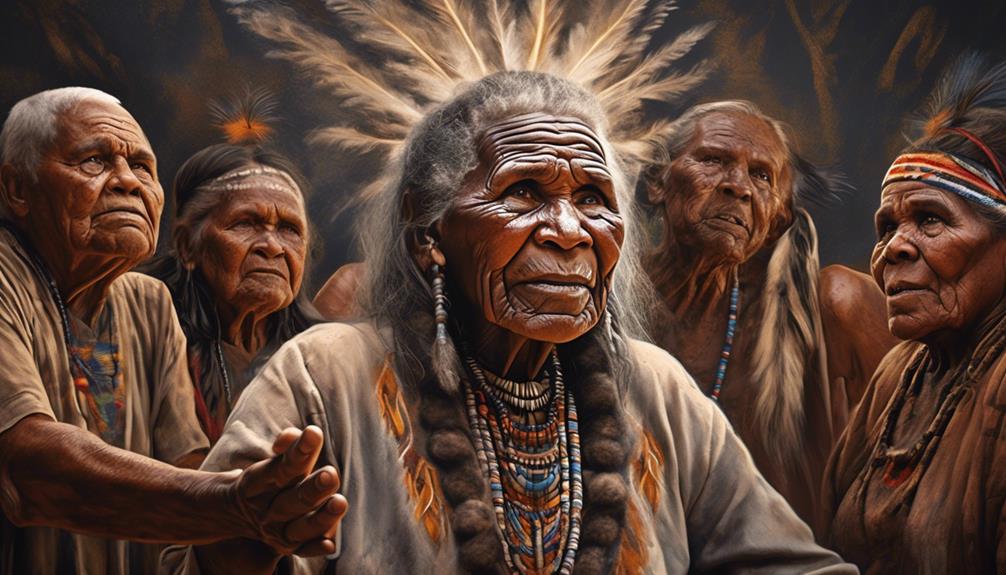
Language and communication play a central role in the Aboriginal definition of culture and identity. Our language isn't just a means of communication; it embodies our history, values, and worldview. It's a vessel through which our ancestors' wisdom and knowledge have been passed down through generations.
In the context of language and communication, we observe the following:
- Language revitalization, cultural preservation: Many Aboriginal communities are actively engaged in language revitalization efforts to reclaim and preserve their native languages. This is crucial for the preservation of our cultural heritage, as language is intrinsically tied to our identity. Through language revitalization, we seek to ensure that future generations can connect with their roots and uphold their traditions.
- Oral traditions, storytelling techniques: Our oral traditions and storytelling techniques are integral to the way we communicate and pass on knowledge. Through storytelling, we transmit our history, cultural values, and spiritual beliefs. These oral traditions foster a deep sense of community and belonging, reinforcing our cultural identity.
- Cultural diversity and linguistic variation: Aboriginal languages are incredibly diverse, reflecting the rich tapestry of our cultures. Each language encapsulates unique perspectives and ways of understanding the world. Embracing this linguistic diversity is vital for recognizing and celebrating the distinctiveness of each Aboriginal group.
- Challenges and resilience: Despite the challenges posed by colonization and forced assimilation, many Aboriginal communities are resiliently striving to reclaim, revitalize, and celebrate their languages. This resilience is a testament to the enduring strength of our cultural identity.
Our languages aren't just a means of communication but the very essence of our cultural identity, connecting us to our ancestors and guiding us into the future.
Art and Expression
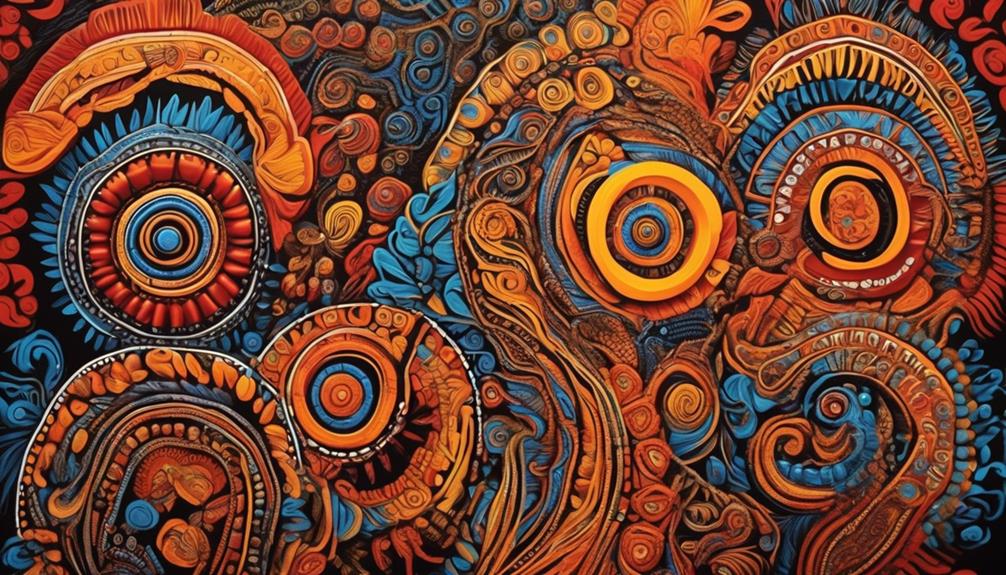
Art and expression serve as powerful mediums through which Aboriginal cultures convey their stories, traditions, and spiritual beliefs, embodying the essence of our identity and heritage. The artistic representation within Aboriginal communities is deeply rooted in cultural symbolism, reflecting the interconnectedness of the land, spirituality, and ancestral knowledge.
When examining our art forms, such as intricate dot paintings, wood carvings, or ceremonial body paintings, we recognize how each stroke, color, and motif carries profound meaning, encapsulating our lived experiences and understanding of the world.
Comparatively, the diverse artistic traditions across Aboriginal groups showcase unique regional styles and interpretations, yet all share a common thread of preserving and sharing cultural narratives. Our art and expressions not only serve as a means of storytelling but also as a form of resistance against historical oppression and a reclamation of our identity. Through art, we assert our presence, resilience, and connection to the land, challenging dominant narratives and reclaiming our space in the world.
Contextually, the significance of art and expression in Aboriginal cultures extends beyond mere aesthetics. It's a living embodiment of our cultural resilience and a testament to the richness of our heritage. By embracing our artistic traditions, we reclaim our agency in shaping the narrative of our people, fostering a sense of empowerment and liberation. In doing so, we celebrate the beauty of our diversity and reaffirm the enduring legacy of our ancestors.
Spiritual Beliefs

Embedded within our cultural practices and traditions, spiritual beliefs play a foundational role in shaping our worldview and guiding our interconnectedness with the natural and spiritual realms. Our spiritual beliefs are deeply rooted in our identity and are integral to our understanding of the world around us. They provide a framework for our relationship with the land, the elements, and all living beings. Our spiritual beliefs aren't confined to a specific place or time; rather, they permeate every aspect of our lives, influencing our actions, decisions, and interactions with others.
- Connection to the Natural World: Our spiritual beliefs emphasize the interconnectedness of all living things and the importance of living in harmony with nature. This interconnectedness is central to our understanding of spirituality and guides our interactions with the natural world.
- Shamanic Practices: Within our spiritual beliefs, shamanic practices hold a significant place. Shamans play a vital role in our communities, serving as intermediaries between the human and spirit worlds. They facilitate healing, provide guidance, and maintain balance within our communities.
- Ritual Ceremonies: Ritual ceremonies are an essential part of our spiritual practices, serving as occasions for honoring the land, ancestors, and spiritual beings. These ceremonies are a way for us to express gratitude, seek guidance, and maintain our connection to the spiritual realm.
- Holistic View of Health: Our spiritual beliefs encompass a holistic view of health, recognizing the interconnectedness of the physical, emotional, and spiritual aspects of well-being. Ritual ceremonies and shamanic practices often play a role in promoting health and healing within our communities.
Environmental Stewardship
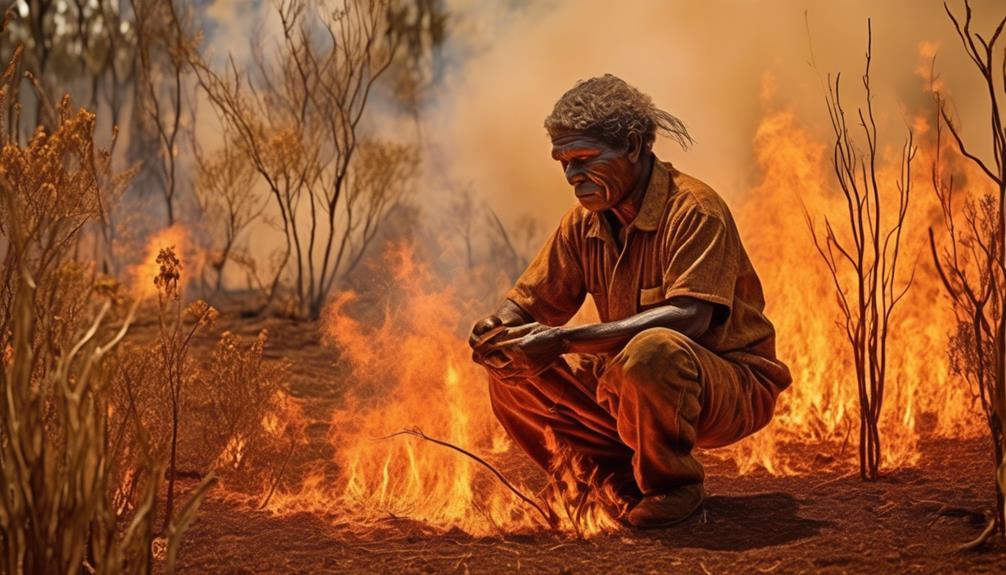
Our deep connection to the natural world guides our role as stewards of the environment, shaping our actions for the benefit of future generations. Traditional practices deeply rooted in our Indigenous identity have long emphasized environmental sustainability and land preservation. Our approach to environmental stewardship is holistic, considering the interconnectedness of all living beings and the land itself. We view the environment not merely as a resource to be exploited, but as a vital and sacred part of our existence.
Comparatively, our traditional practices often stand in stark contrast to modern Western approaches to environmental sustainability. While the dominant culture often prioritizes short-term gains and economic growth, our focus lies in the long-term health and balance of the natural world. Our stewardship isn't solely about managing resources, but about fostering a reciprocal relationship with the environment, understanding that our well-being is intrinsically linked to the health of the land.
Contextually, our environmental stewardship is embedded within our cultural and spiritual beliefs. It isn't a separate or distinct role, but an inherent part of our way of life. The protection and preservation of the land aren't just actions we take, but an expression of our identity and values. Our understanding of environmental stewardship isn't just about the physical act of preservation, but about maintaining the spiritual and cultural connections that bind us to the land for generations to come.
Recognition and Reconciliation
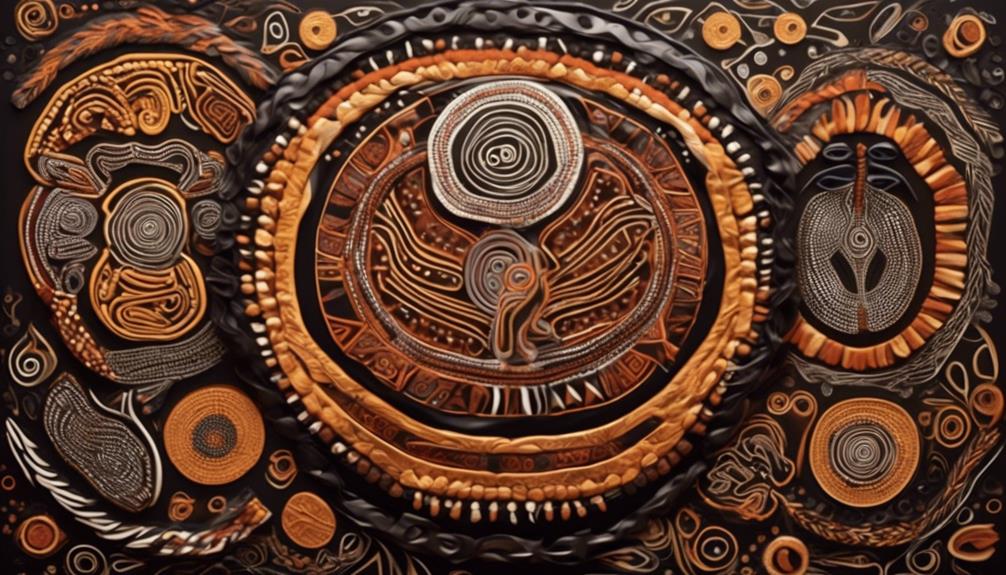
Recognition and reconciliation are vital steps in acknowledging historical injustices and fostering healing and understanding within our communities. As we delve into the significance of recognition and reconciliation, it's essential to acknowledge the impact of these processes on cultural diversity and the revitalization of traditional practices.
Recognition is the first crucial step towards healing and understanding. It involves acknowledging the historical injustices and the enduring impacts on Indigenous communities. By recognizing the past, we validate the experiences of Indigenous peoples and pave the way for meaningful reconciliation.
Reconciliation is a multifaceted process that involves building respectful relationships and addressing the ongoing impacts of colonization. It requires active participation and engagement from all members of society to create a more inclusive and equitable future.
Cultural diversity thrives when recognition and reconciliation are embraced. It allows for the celebration of Indigenous cultures, languages, and traditions, enriching the tapestry of our society.
Revitalization of traditional practices is empowered through recognition and reconciliation. It provides opportunities for Indigenous communities to reclaim and preserve their cultural heritage, passing it on to future generations.
As we navigate the complexities of recognition and reconciliation, it's imperative to approach these processes with humility and openness. Embracing recognition and reconciliation fosters a society where all voices are heard, valued, and respected.
Frequently Asked Questions
How Have Modern Aboriginal Communities Adapted to Contemporary Technology and Globalization?
We've seen modern Aboriginal communities adapt to contemporary technology and globalization by incorporating these advancements within our cultural preservation efforts, enhancing economic participation, and sharing traditional knowledge.
Technology has facilitated connections and enabled us to maintain our cultural identity while participating in the global economy.
We've leveraged our traditional knowledge to navigate the challenges and opportunities brought by globalization, ensuring that our heritage remains a vital part of our modern existence.
What Are Some Common Misconceptions About Aboriginal Spiritual Beliefs and Practices?
Misunderstandings and misinterpretations often cloud the public's perception of Aboriginal spiritual beliefs and practices. These misconceptions stem from a lack of exposure and understanding of the rich and diverse traditions within Aboriginal communities.
It's crucial to challenge these stereotypes and seek to understand the complexities and nuances of Aboriginal spirituality. By doing so, we can begin to break free from the limitations of these misconceptions and embrace a more inclusive and enlightened perspective.
How Do Aboriginal Communities Address Environmental Challenges and Promote Sustainable Practices?
We see environmental stewardship as a core value in Aboriginal communities. Sustainable development is achieved through traditional practices and innovative solutions.
Our approach to addressing environmental challenges involves a deep connection to the land and a commitment to preserving it for future generations. We observe a harmonious balance between human activity and nature, emphasizing the importance of sustainable practices in maintaining ecological integrity.
What Efforts Are Being Made to Recognize and Reconcile the Historical Injustices Experienced by Aboriginal Peoples?
Efforts to recognize and reconcile historical injustices experienced by Aboriginal peoples have gained momentum.
Recognition of past wrongs and efforts to make amends through various initiatives highlight the ongoing commitment to reconciliation.
Historical injustices are being acknowledged and addressed, paving the way for healing and understanding.
The journey towards recognizing and reconciling these injustices is instrumental in building a more inclusive and equitable society.
How Do Aboriginal Communities Navigate the Complexities of Maintaining Cultural Traditions While Also Participating in the Modern Economy?
We observe that many aboriginal communities navigate the complexities of maintaining cultural traditions while participating in the modern economy.
Traditional practices are upheld alongside economic participation, demonstrating a commitment to cultural preservation.
Communities are adapting to globalization while safeguarding their heritage.
This balancing act reflects a desire for liberation, as aboriginal peoples strive to thrive in the modern world while honoring their rich cultural traditions.
Conclusion
As we reflect on the diverse and rich tapestry of Aboriginal definitions, we can't help but wonder: how can we continue to honor and support indigenous communities around the world?
Through recognition and reconciliation, we can work towards a future that respects and celebrates the cultural heritage and contributions of Aboriginal peoples.
It's a journey of understanding and solidarity, one that requires us to listen, learn, and stand in solidarity with indigenous voices.
Mary is a passionate writer who brings creativity and a fresh perspective to our team. Her words have the power to captivate and inspire, making her an essential contributor to our content. Mary’s commitment to storytelling and dedication to promoting Indigenous culture ensures that her work touches the hearts of our readers. We’re fortunate to have her as part of our team.
Aboriginal
How Did Aborigines Get to Australia

The phrase ‘every cloud has a silver lining’ is often used, and when delving into the mystery of the Aborigines’ arrival in Australia, this saying seems particularly fitting.
The journey of the first Australians to the continent is a complex and fascinating puzzle that continues to captivate researchers and enthusiasts alike. With a variety of theories and evidence pointing in different directions, the question of their arrival remains a topic of lively debate.
As we explore the various perspectives and findings, we'll uncover a rich tapestry of insights that shed light on this enduring enigma.
Key Takeaways
- Aboriginal ancestors arrived in Australia around 65,000 years ago through migration from Southeast Asia, supported by archaeological findings and genetic studies.
- Land bridges, particularly Sahul, played a crucial role in facilitating the migration of early humans to Australia during the last Ice Age.
- Ancient sea crossings, aided by maritime navigation and seafaring technologies, shaped the movement patterns of early humans and fostered the exchange of ideas, languages, and technologies.
- Technological advancements, such as the development of watercraft and navigation techniques, allowed for successful migration and influenced the development of cultures.
Ancient Arrival Theories
Ancient Arrival Theories posit various hypotheses regarding the migration of the ancestors of the Aboriginal people to Australia thousands of years ago. One prominent theory suggests that around 65,000 years ago, the first Aboriginal ancestors arrived on the Australian continent. This was during a time when sea levels were much lower, and it's believed that these early inhabitants may have used boats to navigate through Southeast Asia and eventually reached Australia. The evidence supporting this ancient migration theory includes archaeological findings of early human sites in Australia, as well as genetic studies that trace the ancestry of Aboriginal people to this time period.
Another significant aspect of the ancient arrival theories is the potential link between the migration of the Aboriginal ancestors and the megafauna extinction in Australia. Some researchers propose that the arrival of humans in Australia led to the extinction of many of the continent's megafauna, including giant kangaroos and wombats. This hypothesis suggests that the hunting practices of the early Aboriginal inhabitants may have contributed to the decline of these large animal populations. However, this theory is still a topic of debate among archaeologists and scientists.
Understanding the ancient migration of the Aboriginal ancestors and its potential impact on the environment provides valuable insights into the history and cultural heritage of Australia's indigenous population. It allows us to appreciate the deep connection between the Aboriginal people and the land, as well as the complex interactions between human migration and ecological change.
Land Bridges and Ice Age Migration

Our understanding of how Aborigines got to Australia is shaped by the Land Bridge Theory, which suggests that during the last Ice Age, lower sea levels exposed land bridges connecting the continent to Southeast Asia.
This facilitated the migration of early humans and other species. As the climate warmed and sea levels rose, ancient sea crossings may have also played a role in human migration to Australia.
Land Bridge Theory
During the last Ice Age, land bridges were formed, allowing for the migration of early human populations to Australia. The land bridge formation enabled human migration across continents, shaping ice age migration patterns.
This theory suggests that as sea levels dropped due to the formation of glaciers, land connections between continents emerged, providing pathways for human movement. The land bridge between Southeast Asia and Australia, known as Sahul, played a crucial role in the peopling of Australia.
Our understanding of ancient migration is enriched by the study of these land bridge connections, shedding light on the cultural and historical complexities of human movement. The land bridge theory offers valuable insights into the ways in which early populations navigated and settled in distant lands, contributing to the rich tapestry of human history.
Ice Age Migration
The formation of land bridges during the last Ice Age not only facilitated the migration of early human populations to Australia but also significantly influenced the patterns of human movement across continents.
Ice age migration is a complex phenomenon, and the coastal route evidence provides crucial insights into the ways in which ancient peoples navigated and adapted to changing environments.
The discovery of early human artifacts along coastal areas suggests that these populations may have utilized coastal routes to reach Australia, taking advantage of the exposed landmasses during the lower sea levels of the Ice Age. This evidence challenges previous assumptions about migration patterns and highlights the resourcefulness and adaptability of early human populations.
Understanding ice age migration not only sheds light on the history of human movement but also contributes to a more comprehensive appreciation of ancient cultures and their remarkable abilities to traverse challenging landscapes.
Ancient Sea Crossings
Ancient sea crossings and ice age migration have played a crucial role in shaping the movement patterns and cultural exchanges of early human populations across continents. Maritime navigation enabled our ancestors to traverse vast bodies of water, leading to the peopling of Australia and other remote islands. This complex process involved the use of sophisticated seafaring technologies and navigational skills, highlighting the resilience and adaptability of ancient societies.
Additionally, the megafauna extinction forced human populations to adapt their hunting and gathering strategies, triggering migrations in search of new resources. These ancient sea crossings fostered the exchange of ideas, languages, and technologies, contributing to the rich tapestry of human history and the interconnectedness of global cultures.
- Technological Advancements
- Development of watercraft
- Navigation techniques
- Adaptation to maritime environments
Genetic Studies and Ancestral Links

Recent genetic studies have provided compelling evidence for the migration of the ancestors of Aboriginal Australians to the continent. These studies have revealed shared genetic markers between Aboriginal populations and populations in Southeast Asia, supporting the ancestral links between these groups.
Through genetic analysis, researchers have been able to clarify the intricate connections between different indigenous groups and shed light on the complex history of human migration to Australia.
DNA Evidence for Migration
How do genetic studies provide evidence of ancestral links and migration patterns among the Aboriginal people of Australia?
Genetic migrations among Aboriginal populations have been revealed through mitochondrial DNA and Y chromosome studies, shedding light on their deep-rooted ancestral connections and population movements. These studies have demonstrated the genetic diversity and ancient lineages of Aboriginal people, showing connections to specific regions and dispersal patterns.
Additionally, the analysis of whole-genome data has offered insights into the timing and paths of migration, contributing to a better understanding of the complex history of Aboriginal populations.
Moreover, the examination of genetic markers has helped to identify ancestral links between Aboriginal groups and other indigenous populations, providing valuable information about their shared histories and migration routes.
Shared Genetic Markers
Genetic studies have revealed shared markers among Aboriginal populations, providing valuable insights into their ancestral links and migration history. These shared genetic markers indicate common ancestry and shed light on the migration patterns of the first inhabitants of Australia.
By analyzing the genetic diversity and distribution of these markers, researchers can infer the routes and timing of the migration of early human populations. Additionally, the identification of specific genetic adaptations within these populations offers clues about their ability to survive and thrive in diverse environments.
Understanding the shared genetic markers among Aboriginal populations not only enriches our knowledge of human evolution but also fosters a deeper appreciation for the resilience and adaptability of the first Australians in the face of changing landscapes and climates.
Ancestral Connections Clarified
Shared genetic markers among Aboriginal populations have provided valuable insights into their ancestral links and migration history, shedding light on the routes and timing of the migration of the first inhabitants of Australia.
Genetic studies have revealed fascinating details about the ancestral connections and migration patterns of Aboriginal peoples:
- Ancestral Links:
- Genetic analyses have highlighted the deep ancestral connections between Aboriginal populations, tracing back thousands of years.
- Shared genetic markers have shown common ancestry and connections between different Aboriginal groups, emphasizing the unity and interconnectedness of these communities.
- Migration Patterns:
- Studies have indicated multiple waves of migration into Australia, suggesting complex and dynamic movement patterns over time.
- Genetic evidence has provided clues about the timing and pathways of these migrations, enriching our understanding of the ancient peopling of Australia.
Island Hopping Hypothesis

After analyzing archaeological evidence and oceanic navigational capabilities, researchers propose that early human migration to Australia may have occurred through a series of deliberate island-hopping voyages. This hypothesis suggests that ancient populations used their coastal exploration and prehistoric navigation skills to navigate across the islands of Southeast Asia, eventually reaching the Australian continent. This method of migration would have required a deep understanding of ocean currents, seasonal winds, and the locations of islands, showcasing a remarkable level of maritime knowledge for the time period.
| Island Hopping Hypothesis |
|---|
| 1. Coastal Exploration |
| 2. Prehistoric Navigation |
| 3. Navigational Knowledge |
| 4. Southeast Asian Islands |
| 5. Migration to Australia |
The island-hopping hypothesis challenges the traditional notion of accidental drift voyages or purposeful open-sea navigation straight to Australia. Instead, it suggests that early migrants intentionally traveled between islands, establishing temporary or permanent settlements along the way. This theory aligns with the rich oral traditions of Aboriginal Australians, which tell of ancient journeys and connections to neighboring lands. Furthermore, it emphasizes the advanced seafaring capabilities of early humans and the significance of maritime culture in shaping ancient migration patterns.
This hypothesis not only offers a compelling explanation for the peopling of Australia but also sheds light on the ingenuity and adaptability of our ancestors. It invites us to reconsider the ways in which ancient communities navigated and interacted with their environments, encouraging a deeper understanding of human history and cultural evolution.
Indigenous Oral Histories
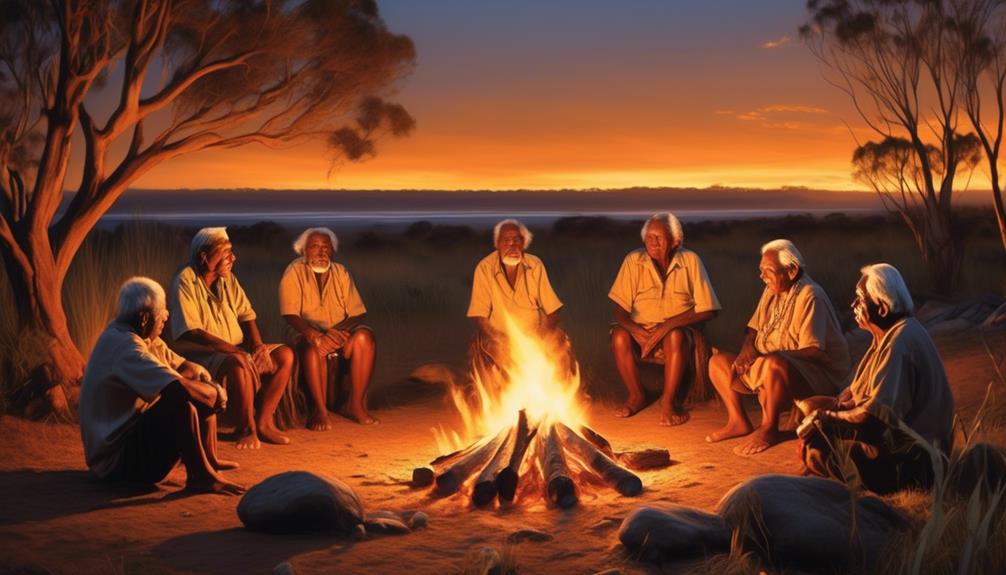
Indigenous oral histories are invaluable sources of cultural knowledge that have been passed down through generations. These oral traditions serve as a means of preserving and transmitting important information about a community's history, customs, and values.
The art of storytelling plays a crucial role in maintaining the rich tapestry of Indigenous cultures and should be recognized for its significance in preserving heritage.
Oral History Preservation
Preserving Indigenous oral histories is a crucial endeavor for safeguarding the cultural heritage and traditions of Aboriginal peoples in Australia. This preservation is vital for maintaining the authenticity of their knowledge transmission techniques and ensuring the continuity of their rich narratives.
To achieve this, various preservation methods are being employed, including:
- Digital Archives: Utilizing modern technology to record and store oral histories, ensuring their accessibility for future generations.
- *Community Involvement*: Engaging Aboriginal communities in the documentation and preservation process, respecting their autonomy and authority over their own narratives.
- *Cultural Institutions Support*: Collaborating with cultural institutions to develop ethical guidelines and protocols for preserving and sharing Indigenous oral histories, respecting the sacred nature of these stories.
Cultural Knowledge Transmission
Utilizing traditional storytelling methods, Aboriginal communities in Australia intricately weave their cultural knowledge into oral histories, ensuring the preservation and transmission of their rich heritage across generations.
Cultural transmission within Indigenous Australian communities is a complex process that involves the passing down of knowledge through storytelling, ceremonies, and artistic expressions. These oral histories serve as a means for preserving traditional practices, spiritual beliefs, and the wisdom of the elders.
Through this intergenerational exchange, the continuity of cultural traditions is maintained, fostering a strong sense of identity and belonging within the community. Furthermore, the oral transmission of knowledge allows for the adaptation and evolution of cultural practices, ensuring their relevance in contemporary contexts.
It's through these oral histories that the resilience and vibrancy of Aboriginal cultures are sustained, contributing to the preservation of their unique heritage.
Importance of Storytelling
Drawing upon the rich tapestry of cultural knowledge transmitted through oral histories, Aboriginal communities in Australia intricately weave the significance of storytelling as a vital vessel for preserving and perpetuating their heritage.
- Preservation Techniques
- Storytelling serves as a mechanism for encoding and preserving Indigenous knowledge, ensuring its continuity across generations.
- Through the art of oral storytelling, traditional practices, beliefs, and values are safeguarded from erosion and loss.
- Indigenous Knowledge Transmission
- Storytelling fosters intergenerational learning, allowing for the seamless transmission of ancestral wisdom and historical accounts.
- The oral tradition enables the preservation of linguistic diversity and ensures the survival of Indigenous languages, which are intrinsic to the narratives shared.
Storytelling, embedded in Indigenous culture, is a powerful tool for the maintenance and transmission of knowledge, offering a profound insight into the historical and cultural legacy of Aboriginal communities.
Archaeological Discoveries

Based on recent archaeological discoveries, it becomes evident that the migration of Aborigines to Australia occurred at least 65,000 years ago. Archaeological excavations have unearthed cultural artifacts such as stone tools, shell beads, and rock art that provide crucial evidence of the ancient settlement patterns and migration routes of the first Aboriginal peoples. These findings challenge previous beliefs about the timeline of human migration and settlement in Australia.
The discovery of ancient tools and artifacts in various locations across Australia, including the Madjedbebe rock shelter in the Northern Territory, indicates a sophisticated adaptation to different environments. The tools and artifacts suggest a high level of technological advancement and cultural complexity among the early Aboriginal inhabitants. Additionally, the presence of these artifacts in diverse ecological settings suggests that the migration and settlement patterns weren't haphazard but rather followed intentional and well-planned routes.
Understanding the ancient settlement patterns and migration routes of the Aboriginal peoples is crucial for appreciating the depth of their history and the richness of their cultural heritage. These archaeological discoveries not only provide insights into the earliest human societies in Australia but also challenge mainstream narratives about human migration and the development of complex societies.
Maritime Navigation Techniques
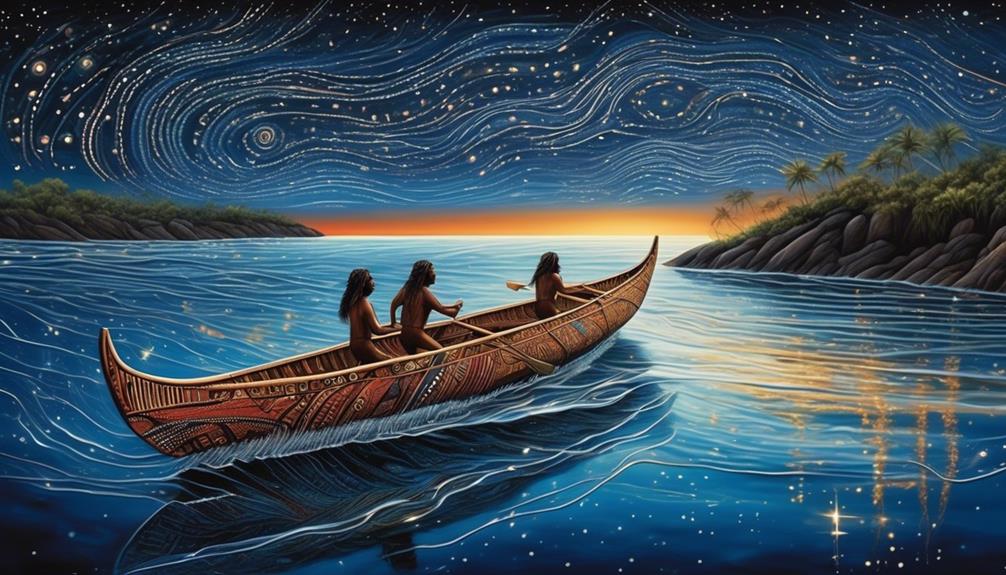
Our exploration of the migration of Aborigines to Australia prompts an investigation into the maritime navigation techniques employed by these early seafarers. The ability of Indigenous Australians to navigate vast oceanic distances to reach Australia reflects a sophisticated understanding of celestial navigation techniques and traditional maritime knowledge.
- Celestial Navigation Techniques
Indigenous seafarers utilized celestial bodies such as stars, sun, moon, and even specific constellations to determine direction and location. This intricate understanding of celestial navigation enabled them to navigate across open waters with precision, even in the absence of modern navigational instruments.
- Indigenous Seafaring Traditions
The maritime navigation techniques of Indigenous Australians were embedded within their cultural practices and traditions, passed down through generations. These traditions encompassed not only the technical aspects of navigation but also the spiritual and cultural significance of seafaring, emphasizing a holistic understanding of the ocean and its navigation.
- Navigation Tools and Traditional Maritime Knowledge
Indigenous Australians developed and utilized various navigation tools such as stick charts, shells, and other natural materials, which played a significant role in their navigation across the vast expanses of the Pacific Ocean. Moreover, traditional maritime knowledge encompassed a deep understanding of ocean currents, wind patterns, animal behavior, and environmental cues, all of which contributed to their successful navigation.
The maritime navigation techniques of early Indigenous Australians exemplify a profound connection to the natural world and a remarkable mastery of navigating the seas, demonstrating their advanced understanding of the maritime environment and their ability to traverse great distances with ingenuity and skill.
Ancient Seafaring Technology

Utilizing sophisticated maritime technology, ancient seafarers navigated the vast oceans with remarkable precision and skill, reflecting a deep understanding of the maritime environment and its challenges. The ancient seafaring technology utilized by these early mariners was a testament to their ingenuity and adaptability. Their ability to traverse long distances across open waters, often without the aid of modern navigational tools, is a testament to their advanced knowledge of celestial navigation, ocean currents, and weather patterns.
Through the use of traditional navigation methods such as celestial navigation, landmark identification, and oral navigational lore, ancient seafarers were able to undertake long and perilous journeys with astounding accuracy.
Maritime technology of the ancient world encompassed a wide range of tools and techniques, including the development of watercraft suited for open-sea travel, the creation of navigational aids such as charts and maps, and the utilization of observational astronomy for determining latitude and longitude. These advancements in maritime technology allowed ancient seafarers to venture into the unknown, expanding their cultural and commercial horizons. Their mastery of ancient navigation techniques not only facilitated trade and cultural exchange but also paved the way for future explorations and migrations.
Understanding the intricacies of ancient seafaring technology provides valuable insights into the capabilities and accomplishments of early maritime societies. It highlights the resourcefulness and resilience of ancient seafarers who, armed with their knowledge and expertise, bravely ventured into the vast and unpredictable expanse of the open ocean.
Climate Change and Coastal Routes

As we consider the migration of Aborigines to Australia, the evidence of coastal routes becomes a crucial element in understanding their journey.
The impact of changing sea levels due to climate change offers insights into the feasibility and timing of such migrations.
Coastal Route Evidence
During periods of climate change, coastal routes may have played a significant role in the migration of early human populations to Australia. Coastal route migration is supported by evidence of prehistoric seafaring techniques, indicating that ancient humans could have traveled along coastlines using boats or rafts. This method would have allowed them to navigate through changing landscapes and access new territories, including Australia.
The discovery of early human artifacts along coastal regions further suggests the plausibility of this migration route. Additionally, genetic studies of Aboriginal populations have provided insights into their deep-rooted connection to coastal regions, supporting the hypothesis of coastal migration.
These findings underscore the importance of considering coastal routes in understanding the complex and dynamic history of human migration to Australia.
Impact of Sea Levels
The evidence of prehistoric seafaring techniques highlights the significant impact of sea levels on coastal routes and human migration to Australia. Sea level fluctuations have played a crucial role in shaping the environmental impact and ancient settlement patterns of the continent.
As sea levels varied over millennia, coastlines shifted, creating opportunities for migration and posing challenges for early inhabitants. These fluctuations influenced the availability of coastal resources and the suitability of routes for human migration.
Understanding the complex interplay between sea level changes and human migration is essential for comprehending the history of ancient settlement in Australia. It offers valuable insights into how early populations navigated and adapted to the dynamic coastal landscapes, shedding light on the resilience and resourcefulness of the first Australians in the face of environmental challenges.
Migration Timing Implications
Examining the implications of climate change and coastal routes on the timing of migration offers valuable insights into the adaptive strategies of ancient populations in navigating and settling in Australia. This analysis sheds light on the implications of early arrival, as well as the environmental adaptation challenges faced by these early migrants.
- Impact of Sea Levels: Understanding the fluctuation of sea levels and its impact on coastal routes provides crucial context for evaluating migration timing.
- *Coastal Navigation Techniques*: Exploring the techniques utilized by ancient populations for coastal navigation can reveal their resourcefulness in overcoming environmental challenges.
- *Cultural Resilience*: Investigating how cultural traditions and knowledge were leveraged to adapt to changing coastal landscapes offers a deeper understanding of the resilience of these early populations.
- *Resource Management*: Delving into how ancient populations managed resources in response to environmental changes can provide insights into their adaptive capabilities.
Megafauna Extinction Connection

New evidence supports the theory that the arrival of humans in Australia is linked to the extinction of the continent's megafauna. The timing of human migration to Australia coincides with the decline and eventual extinction of many large animal species, known as megafauna. This correlation has sparked debate over whether human activity, environmental changes, or a combination of both factors contributed to the megafauna extinction.
| Megafauna Extinction Theories | Description |
|---|---|
| Overhunting | This theory posits that the rapid increase in human population led to the overexploitation of megafauna for food, resulting in their extinction. |
| Environmental Changes | The environmental changes theory suggests that alterations in the landscape due to climate variability or human activity led to the decline of megafauna habitats and food sources. |
| Coexistence | Some researchers propose that while human arrival may have impacted megafauna, the two coexisted for a significant period before the extinction, indicating that other factors may have played a more significant role. |
The megafauna extinction and its connection to human arrival in Australia are essential topics of discussion as they shed light on how human activity can impact ecosystems. Understanding the complex interplay between human migration, environmental changes, and megafauna extinction is crucial for learning from the past and making informed decisions about conservation and sustainability. By examining these historical events, we can gain insights into the delicate balance between human societies and the natural world, leading to a more liberated and environmentally conscious future.
Adaptation to New Environments

Researchers have identified various cultural and technological adaptations employed by early human populations as they navigated and settled into the diverse environments of Australia. The cultural adaptation of the Aboriginal people to the new environment was crucial for their survival and development. Here are the key cultural and technological adaptations that enabled the early human populations to thrive in the challenging Australian landscapes:
- Use of Fire: The controlled use of fire was a crucial cultural adaptation that allowed Aboriginal people to manage the landscape, promote new growth, and facilitate hunting.
- Tool Innovation: Early inhabitants of Australia demonstrated remarkable technological adaptations by crafting specialized tools suited to the unique environments they encountered, such as the development of complex tools for hunting and food processing.
- Social Organization: The Aboriginal people developed intricate social structures that facilitated cooperation and knowledge sharing, enabling them to adapt to different ecological niches and climates.
These cultural adaptations reflect the environmental resilience of the early human populations in Australia. The ability to adapt culturally and technologically allowed them to thrive in diverse and often harsh environments. The resilience and adaptability of Aboriginal cultures demonstrate the depth of human ingenuity and the capacity for innovation in the face of environmental challenges.
Understanding these cultural and technological adaptations provides valuable insights into the history and development of human societies in Australia.
Early Settlement Evidence

The cultural and technological adaptations of the Aboriginal people in managing the landscape and promoting new growth provide key insights into the early settlement evidence in Australia. Archaeological discoveries have shed light on the ways in which the Aboriginal people adapted to new environments over time. These discoveries have revealed sophisticated tools and methods used for hunting, cooking, and building shelters, indicating a deep understanding of the natural resources available in different regions.
Additionally, the impact of sea levels on early settlement evidence is evident in the remnants of ancient coastal settlements that have been uncovered by researchers. These sites offer valuable clues about the lifestyles and migration patterns of the early Aboriginal inhabitants.
Furthermore, the adaptation to new environments is demonstrated through the diversity of tools and artifacts found across various regions of Australia. The differences in materials and construction techniques reflect the resourcefulness and adaptability of the Aboriginal people as they navigated and settled in diverse landscapes.
The early settlement evidence also highlights the significance of oral traditions and storytelling as a means of passing down knowledge of land management and survival strategies through generations.
Cultural Connections to Southeast Asia

With evidence of cultural practices and linguistic similarities, the enduring connections between Aboriginal communities and Southeast Asia are indicative of a deep-rooted historical and cultural exchange. These connections provide valuable insights into the complex web of Indigenous migration routes and the diverse ways in which cultures have intertwined over millennia.
- Cultural Practices: The presence of intricate rock art, use of specific tools, and shared mythological motifs between Aboriginal communities and Southeast Asian cultures underscores the enduring cultural connections. These similarities suggest a sustained and meaningful exchange of knowledge and practices.
- Linguistic Similarities: Linguistic research has revealed striking similarities between certain Aboriginal languages and those spoken in parts of Southeast Asia. These linguistic connections offer compelling evidence of historical ties and interactions between the two regions, pointing to long-standing cultural exchanges.
- Material Culture: Archaeological findings of similar stone tools, pottery styles, and burial practices in both regions further emphasize the enduring cultural connections and exchange between Aboriginal communities and Southeast Asia. These material cultural similarities indicate a sustained and reciprocal transfer of knowledge and technologies, shaping the identities of both regions.
These cultural connections to Southeast Asia provide a deeper understanding of the historical and cultural exchange that has shaped the identities of Aboriginal communities and the broader Southeast Asian region. They illustrate the intricate web of Indigenous migration routes and highlight the rich tapestry of connections that have endured over time.
Ancient Trade and Exchange Networks

Evidence of ancient trade and exchange networks illuminates the interconnectedness of diverse cultures and the enduring impact of historical interactions. The trade routes that crisscrossed the ancient world facilitated not only the movement of goods but also the exchange of ideas, technologies, and cultural practices.
In the context of the migration of the Aborigines to Australia, these trade routes played a crucial role in shaping the cultural landscape of the region and in providing the means for their eventual arrival.
The interconnected web of trade routes, spanning from Southeast Asia through the Indonesian archipelago and into Australia, allowed for the exchange of materials such as volcanic glass, known as obsidian, and other resources. This trade facilitated the movement of people and ideas, contributing to the rich tapestry of cultural exchange that characterized the region. The intricate networks of interaction and exchange weren't only vital for the sustenance of communities but also for the transmission of social, religious, and technological innovations.
The cultural exchange that occurred along these trade routes wasn't a one-way process but rather a dynamic and reciprocal interaction, where different societies contributed to and benefitted from the amalgamation of knowledge and practices. This exchange of goods and ideas across vast distances underscores the sophisticated systems of navigation, communication, and diplomacy that existed in ancient times.
Understanding the dynamics of ancient trade and exchange networks provides valuable insights into the complex and interconnected histories of diverse cultures, shedding light on the enduring impact of historical interactions.
Human Evolution and Migration Patterns

Ancient trade and exchange networks reveal a complex web of interactions and cultural interconnections, providing valuable insights into the patterns of human evolution and migration across diverse regions. Human migration is a remarkable saga of adaptation and resilience, marked by the interplay of evolutionary genetics, ancient seafaring techniques, and climate change adaptation. Coastal route evidence suggests that early humans navigated the seas, dispersing across continents and islands. This underscores the significance of maritime capabilities in shaping the human story.
- *Evolutionary Genetics*: Genetic studies have unraveled the intricate tapestry of human migration, highlighting the movements of ancient populations and their genetic legacies in present-day communities. These findings offer profound insights into the interconnectedness of human populations and the dynamics of migratory patterns.
- *Ancient Seafaring Techniques*: The mastery of ancient seafaring techniques, such as navigation by the stars and knowledge of ocean currents, facilitated the expansion of human populations to distant lands. This underscores the ingenuity of our ancestors and their ability to adapt to diverse environments.
- *Cultural Exchange Networks*: The exchange of ideas, technologies, and cultural practices within and between different human groups played a pivotal role in shaping migration patterns. These cultural exchange networks fostered the transmission of knowledge and innovations, contributing to the rich tapestry of human diversity and interconnectedness.
Understanding human evolution and migration patterns provides a lens through which we can appreciate the shared heritage of humanity, transcending geographical boundaries and celebrating the resilience and ingenuity of our ancestors.
Frequently Asked Questions
What Were the Specific Routes and Methods Used by the Ancient Aborigines to Navigate to Australia?
Ancient navigation and migration patterns of the aborigines to Australia are fascinating. Their journey was a testament to incredible seafaring skills and a deep understanding of the land and sea.
The specific routes and methods used by the ancient aborigines to navigate to Australia reflect their connection to the environment and their ability to adapt and thrive in diverse landscapes.
Their migration patterns offer valuable insights into their rich cultural history and resilience.
How Did the Megafauna Extinction in Australia Impact the Migration and Settlement Patterns of the Early Aborigines?
The megafauna extinction in Australia significantly impacted the migration and settlement patterns of the early Aborigines. As they adapted to new ecosystems, they adjusted their navigation methods and cultural connections with Southeast Asia.
This shift is evident in the evidence of human evolution and migration. The loss of megafauna influenced their cultural perspective and affected their liberation, shaping their journey and settlement in Australia.
What Cultural and Trade Connections Did the Early Aborigines Have With Other Southeast Asian Societies?
Cultural connections between early Aborigines and Southeast Asian societies were robust and diverse. Trade networks facilitated the exchange of goods, technologies, and cultural practices, enriching both communities.
The intricate web of connections fostered a sense of belonging and mutual understanding, transcending geographical boundaries. These exchanges were vital for shaping the cultural identity of the early Aborigines and Southeast Asian societies, illustrating the power of human interaction and exchange in shaping civilizations.
How Did the Early Aborigines Adapt to the New Environments and Ecosystems They Encountered in Australia?
Adapting to new environments and ecosystems posed significant challenges for early Aboriginal communities. Environmental changes required us to develop innovative strategies for survival. This process encompassed a deep understanding of the land, its resources, and the complex interactions within the ecosystem.
Our cultural perspective emphasizes the importance of respecting and harmonizing with nature. Through this lens, we navigated the adaptation challenges brought about by the unique Australian landscape.
What Specific Evidence Exists for the Human Evolution and Migration Patterns of the Ancient Aborigines?
Genetic evidence and archaeological findings provide insights into the human evolution and migration patterns of ancient Aborigines. Climate change and land bridges played pivotal roles in their journey to Australia. These factors influenced their adaptation to diverse environments and the development of unique cultural practices.
Our research underscores the significance of understanding these migration patterns in appreciating the rich history and cultural heritage of the ancient Aborigines.
Conclusion
In conclusion, the fascinating journey of how the Aboriginal people arrived in Australia is a complex and awe-inspiring tale of ancient migration, cultural connections, and human evolution.
From land bridges and ice age migration to genetic studies and indigenous oral histories, the story of their arrival is a testament to the resilience and adaptability of the human spirit.
The depth of their ancestral links and early settlement evidence only adds to the richness of their cultural heritage.
Talise is a talented writer and an expert in her field. Her unique perspective and insights enrich our content with depth and authenticity. With a wealth of knowledge and a strong connection to the subjects she writes about, Talise crafts engaging and informative articles that resonate with our readers. Her dedication to bringing Indigenous culture and wisdom to light is truly commendable.
Aboriginal
Abriginal History
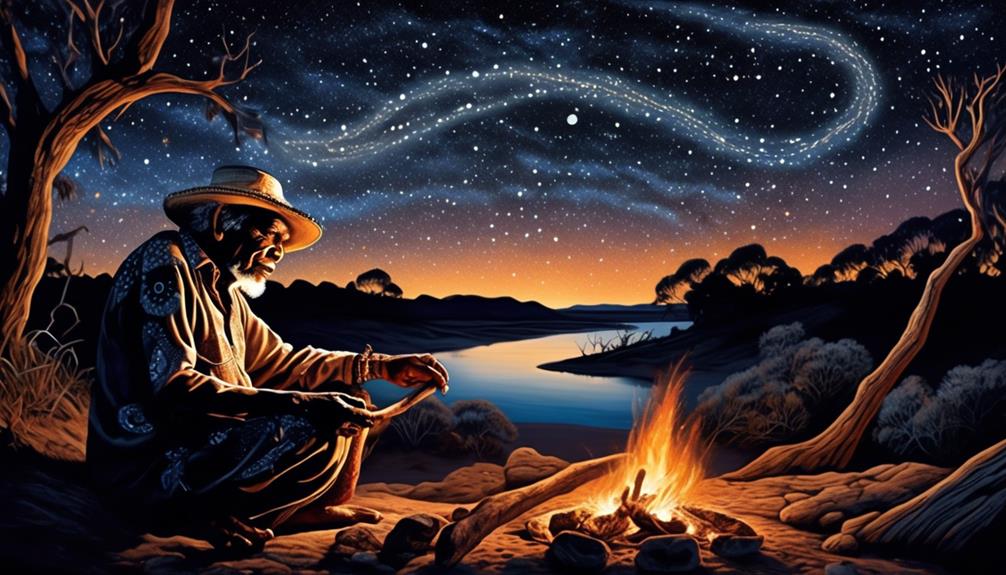
How much do we really know about the history of Indigenous peoples?
The rich and complex tapestry of Indigenous cultures and traditions in Australia holds a wealth of knowledge that often goes unexplored.
As we begin to peel back the layers of this history, we uncover stories of resilience, resistance, and survival.
However, there is still much more to uncover and understand about the impact of British colonization, the ongoing political activism and advocacy, and the future prospects for reconciliation and healing.
Key Takeaways
- The Dreamtime and Creation Stories are integral to Aboriginal history and culture.
- British colonization had a significant impact on Aboriginal cultures, leading to resistance and survival strategies.
- The Stolen Generations and assimilation policies have had a lasting impact on Aboriginal communities.
- Land rights and sovereignty have been important issues for Aboriginal people, leading to legal battles and the Indigenous Sovereignty Movement.
The Dreamtime and Creation Stories
In Aboriginal culture, the Dreamtime and Creation Stories are foundational narratives that provide an understanding of the origins of the world and all living things. These Dreamtime beliefs and creation stories aren't just tales; they're the essence of our spiritual connection to the land, the animals, and each other.
Passed down through generations via oral traditions, these stories hold immense cultural significance for us, as they shape our worldview and guide our behavior.
The Dreamtime beliefs aren't confined to the past; they're alive in the present and inform our future. They aren't myths but living stories that connect us to our ancestral beings and the natural world. The Dreamtime is where the past, present, and future meet, and it's through these stories that we understand our place in the world and our responsibilities to it.
Our creation stories aren't mere explanations of how the world came to be; they're a means of understanding our interconnectedness with the land and all living beings. They teach us respect, reciprocity, and the importance of living in harmony with nature.
These stories aren't just part of our history; they're the guiding principles of our present and our hopes for the future. Therefore, they're integral to our identity and our existence.
Pre-Colonial Aboriginal Cultures
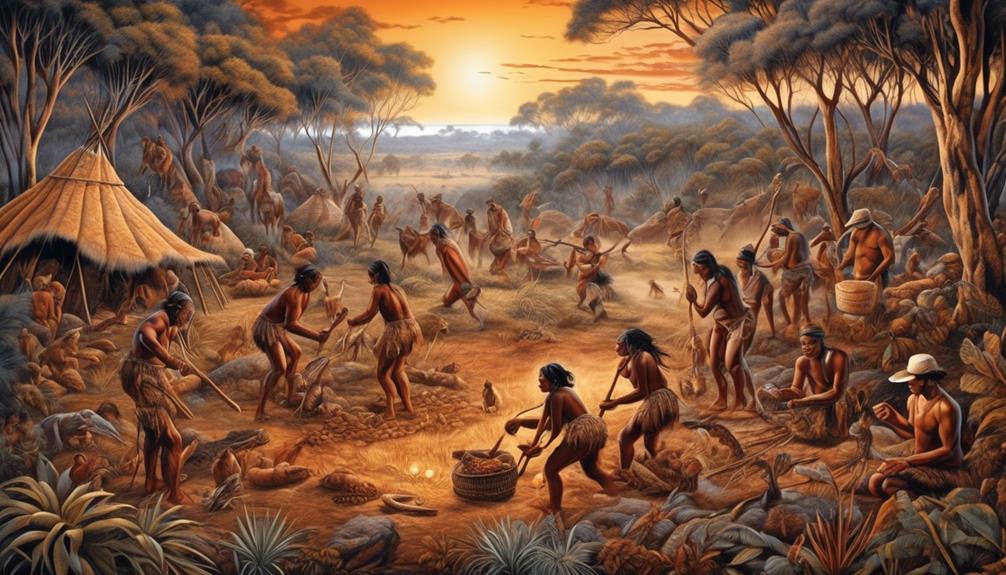
How did Aboriginal cultures evolve prior to colonization, and what were their key characteristics and values?
Pre-colonial Aboriginal cultures were rich and diverse, shaped by traditions, customs, and values that have been passed down through generations. Here are key aspects of these cultures:
- Tribal Customs: Aboriginal societies were organized into various tribes, each with its own unique customs, languages, and social structures. These customs played a crucial role in governing interpersonal relationships, resolving conflicts, and maintaining harmony within the community.
- Traditional Practices: The daily lives of Aboriginal peoples were intertwined with a wide array of traditional practices, including hunting, gathering, fishing, and ceremonies. These practices were deeply rooted in spiritual beliefs and were essential for the survival and well-being of the community.
- Connection to Land: Land held profound spiritual and cultural significance for Aboriginal peoples. They had a deep connection to the land, viewing it as a source of sustenance, spirituality, and identity. Their custodianship of the land was based on a profound respect for nature and the environment.
- Oral Traditions: Aboriginal cultures relied heavily on oral traditions to convey knowledge, history, and spiritual beliefs. Elders played a central role in passing down stories, songs, and wisdom to younger generations, ensuring the preservation of their heritage.
The pre-colonial Aboriginal cultures were characterized by a strong sense of community, a deep connection to the land, and a rich tapestry of traditions and customs that contributed to their resilience and cultural vibrancy.
Impact of British Colonization
Upon the arrival of British colonization, the intricate social structures and deeply rooted traditions of the pre-colonial Aboriginal cultures were profoundly disrupted, leading to significant and enduring impacts on the Indigenous communities. The British colonial impact was marked by policies aimed at cultural assimilation, which sought to replace Indigenous cultures with British norms and values. This led to the erosion of traditional Indigenous practices, languages, and belief systems, as well as the breakdown of familial and community structures that had sustained the Aboriginal peoples for generations.
In the face of such colonial pressure, Indigenous resistance and cultural preservation became vital strategies for survival. Many Indigenous communities actively resisted the attempts to assimilate them into British culture, seeking to maintain their unique identities and traditional ways of life. Despite facing immense challenges, they tenaciously preserved their cultural heritage through oral traditions, ceremonies, and art forms, thus safeguarding their ancestral knowledge and wisdom for future generations.
The impact of British colonization on Aboriginal communities continues to reverberate today, shaping the socio-economic disparities and health inequities experienced by Indigenous peoples. Understanding and acknowledging this historical trauma is crucial for reconciliation and healing. By recognizing the resilience and strength of Indigenous communities in the face of cultural assimilation, we can work towards fostering a society that values and respects the diversity of Indigenous cultures, while supporting their ongoing efforts to preserve and revitalize their rich heritage.
Resistance and Survival
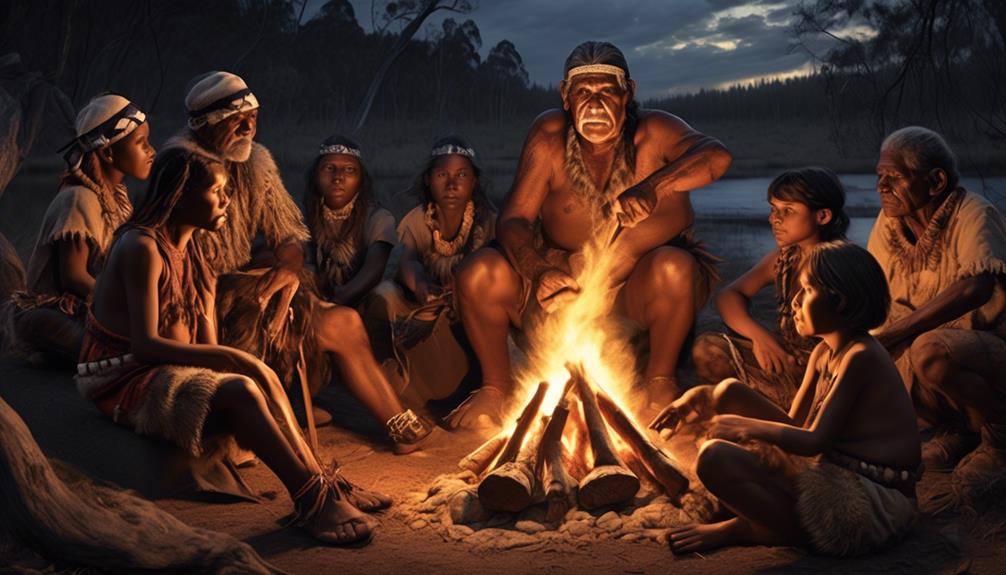
Reflecting on the resilience and strength of Indigenous communities amidst colonial pressures, we witness a profound commitment to preserving their cultural heritage and traditional ways of life. This unwavering dedication has led to the development of remarkable resistance strategies and survival techniques that have allowed Indigenous peoples to persevere through centuries of adversity.
- Cultural Preservation: Indigenous communities have fiercely guarded their languages, stories, and traditions, passing them down through generations despite attempts to erase and assimilate their cultures.
- Sustainable Living: By utilizing traditional ecological knowledge, Indigenous peoples have sustained themselves through hunting, fishing, and farming practices that are deeply rooted in respect for the land and its resources.
- Community Solidarity: In the face of external pressures, Indigenous communities have come together to support each other, forming networks of mutual aid and solidarity to navigate through difficult times.
- Adaptive Resistance: Indigenous peoples have demonstrated remarkable adaptability, finding ways to resist oppressive systems while simultaneously preserving their identities and ways of life.
The resilience and strength of Indigenous communities in upholding their cultural heritage and traditional practices are awe-inspiring. Their resistance strategies and survival techniques not only reflect their determination to thrive against all odds but also offer valuable lessons in sustainable living, community solidarity, and adaptive resistance for all who seek to build a more just and equitable world.
Stolen Generations and Assimilation Policies
Resilient in the face of adversity, Indigenous communities have faced the devastating impact of Stolen Generations and Assimilation Policies, enduring the profound repercussions of these historical injustices. The forced removal of Indigenous children from their families and communities, and the implementation of assimilation policies, aimed to erase Indigenous cultures and identities. The intergenerational trauma caused by these policies continues to affect Indigenous communities, challenging the preservation of their cultural heritage and identity.
The Australian government's formal apology in 2008 was a significant step towards acknowledging the immense harm caused by these policies. However, the journey towards healing and reconciliation is ongoing. Efforts to provide reparations to the Stolen Generations and support cultural preservation are crucial for addressing the legacy of this dark chapter in history. Truth-telling about the experiences of the Stolen Generations is essential for both Indigenous and non-Indigenous Australians to understand the lasting impact of these injustices.
The healing journey involves confronting the colonial legacy that perpetuated these harmful policies and working towards creating a more inclusive and equitable society. It requires a commitment to supporting Indigenous communities in reclaiming and celebrating their cultural identity. By amplifying Indigenous voices and experiences, we can foster understanding, empathy, and solidarity.
Together, we can strive to create a future where the rights and dignity of Indigenous peoples are honored, and where the wounds of the past are healed.
Land Rights and Sovereignty
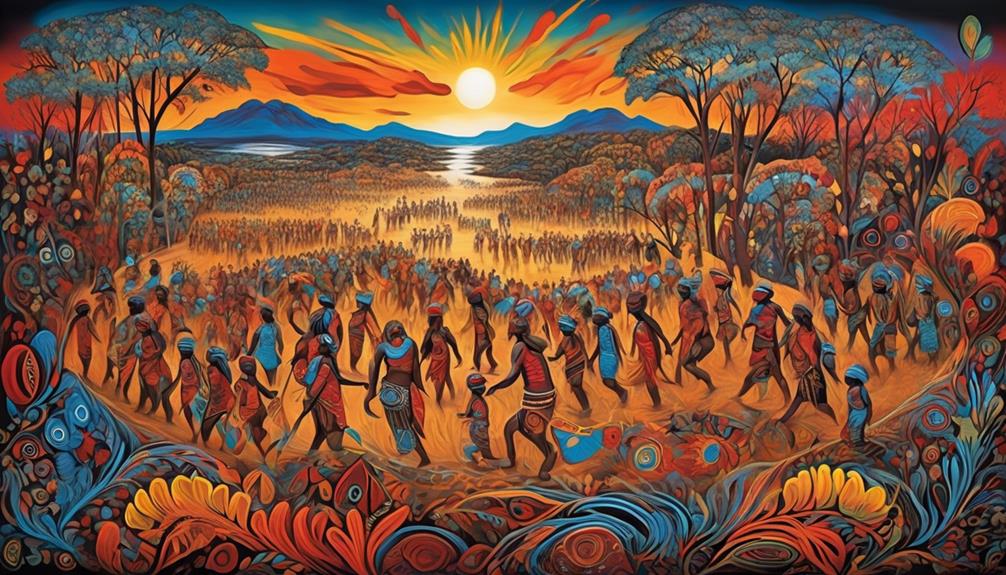
We've seen the ongoing struggle for land ownership rights and the movement for Indigenous sovereignty gain significant attention in recent years.
The legal battles for land have been a focal point in the fight for Aboriginal rights and self-determination.
These issues are deeply intertwined with the history and identity of Indigenous peoples, and they continue to shape the path forward for reconciliation and justice.
Land Ownership Struggles
Through centuries of struggle and perseverance, Aboriginal communities have fought for their land rights and sovereignty, facing immense challenges along the way. The ownership struggles and historical injustices have deeply impacted our communities, but we continue to advocate for our inherent rights to the land.
Here's why this fight for land ownership is crucial:
- Cultural Preservation: Our connection to the land is integral to our culture and identity, making land ownership essential for preserving our heritage.
- Socio-Economic Empowerment: Owning land provides opportunities for economic self-sufficiency, empowering our communities to thrive independently.
- Environmental Stewardship: As traditional custodians of the land, ownership allows us to continue our role as responsible stewards of the environment.
- Sovereignty and Autonomy: Land ownership is fundamental to our sovereignty, enabling self-governance and autonomy in decision-making processes.
Indigenous Sovereignty Movement
The Indigenous Sovereignty Movement for land rights and autonomy has been a pivotal force in advocating for the inherent rights of Aboriginal communities. As Indigenous peoples, we assert our right to self-determination and the protection of our ancestral lands. Our movement seeks to challenge colonial systems and assert Indigenous rights, acknowledging that our connection to the land is not just physical, but spiritual and cultural. Through this movement, we aim to dismantle oppressive structures, reclaim our traditional governance, and ensure the sustainability of our communities. Our struggle for self-determination is deeply rooted in our history and continues to shape our present and future. We stand united in demanding recognition of our sovereignty and the right to govern ourselves in accordance with our customs and traditions.
| Indigenous Rights | Self-Determination | Land Autonomy | Cultural Preservation |
|---|---|---|---|
| Advocating for the recognition of inherent rights | Asserting the right to govern ourselves | Challenging colonial land ownership systems | Protecting spiritual and cultural connections to the land |
Legal Battles for Land
Engaging in legal battles for land rights and sovereignty has been a critical aspect of our ongoing struggle for the recognition of our inherent rights as Indigenous peoples. The fight for land ownership is deeply rooted in our history and continues to shape our present and future.
Here's why it matters:
- Historical Injustices: Our ancestors' lands were forcibly taken, and reclaiming them is a way to address past wrongs.
- Cultural Preservation: Land isn't just property; it's integral to our cultural identity and traditional practices.
- Economic Empowerment: Securing land rights enables us to build sustainable economies for our communities.
- Sovereignty and Self-Determination: Control over our lands is fundamental to our self-governance and autonomy.
We are committed to these legal battles because they're essential to our liberation and the preservation of our culture and identity.
Contemporary Aboriginal Identity
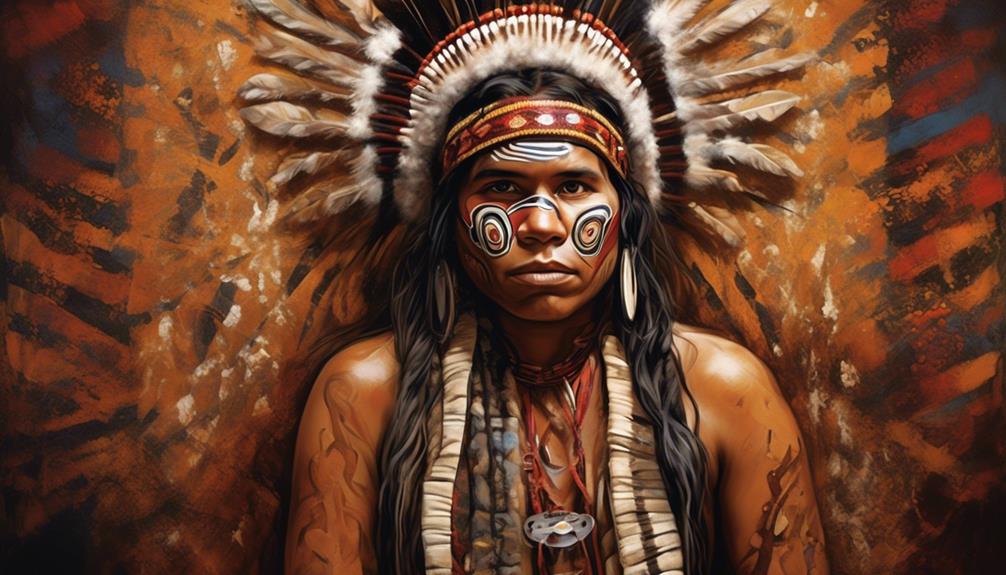
Navigating the complexities of contemporary Aboriginal identity requires an understanding of the rich tapestry of cultural, social, and historical influences. In our current reality, cultural identity is a dynamic and multifaceted concept, shaped by traditional practices, intergenerational trauma, and the ongoing effects of colonization. We, as a community, face contemporary challenges that intersect with our cultural identity, such as the preservation of languages, the revitalization of cultural practices, and the assertion of sovereignty over our lands.
Our cultural identity is deeply intertwined with our sense of self and belonging. The struggle to maintain our cultural heritage in the face of modernity and globalization is an ongoing battle. We must confront the impacts of historical trauma, including the forced assimilation policies of the past, which continue to reverberate through our communities today. However, we also celebrate the resilience and strength that has allowed us to preserve our cultural traditions and adapt to the changing world around us.
Contemporary Aboriginal identity is also marked by a quest for self-determination and empowerment. We're reclaiming our narratives, challenging stereotypes, and asserting our presence in various spheres of society. Our journey towards contemporary Aboriginal identity is one of resilience, resistance, and reclamation.
As we navigate these complexities, we must honor the diversity and individual experiences within our community, fostering a space where every Aboriginal person feels seen, heard, and valued.
Aboriginal Art and Cultural Expression
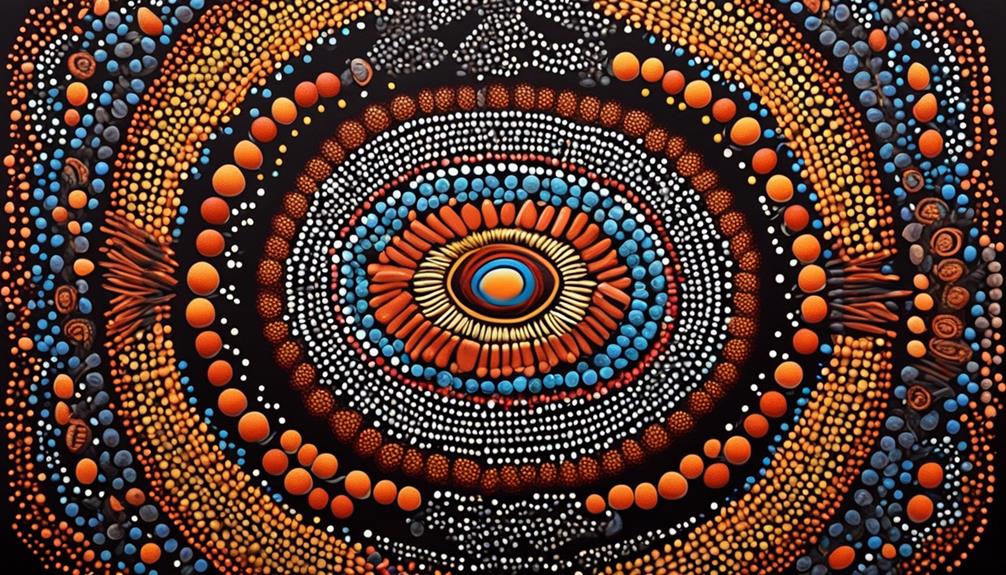
Embracing our traditional art forms and cultural expressions allows us to share our stories and connect with our heritage in meaningful ways. Aboriginal art is a powerful vehicle for cultural preservation and a means of expressing our identities. Here are four reasons why Aboriginal art and cultural expression are vital:
- Cultural Preservation: Through art, we preserve our ancestral knowledge, traditions, and spiritual beliefs. Each stroke of the brush or mark on a piece of bark carries the stories of our people, ensuring that our rich cultural heritage endures for future generations.
- Traditional Storytelling: Aboriginal art serves as a visual form of traditional storytelling, depicting creation stories, ancestral journeys, and daily life. These artworks aren't merely decorative; they're intricate narratives that convey our history and wisdom.
- Modern Interpretation: While rooted in tradition, Aboriginal art also evolves with modern interpretations. Artists infuse contemporary issues, experiences, and perspectives into their work, ensuring that our cultural expression remains relevant and dynamic.
- Connecting Communities: Aboriginal art fosters connections within our communities and beyond. It serves as a bridge for non-Indigenous people to engage with and understand our culture, promoting empathy, respect, and unity.
Our art and cultural expressions are integral to our identity, serving as a form of resistance, resilience, and celebration. By embracing and honoring these forms, we continue to affirm our existence and contribute to the liberation of our people.
Indigenous Knowledge and Traditions
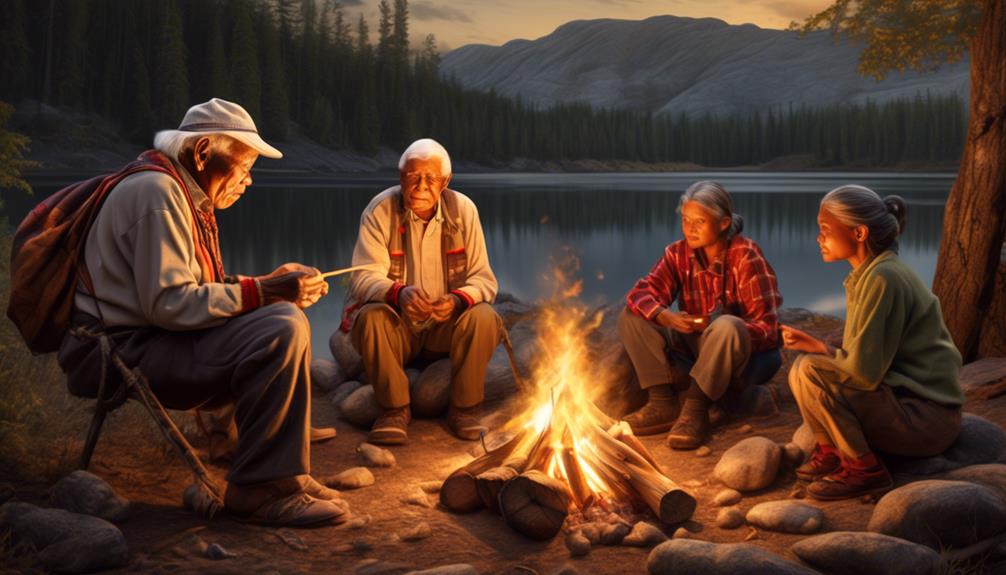
Preserving and passing down Indigenous knowledge and traditions is a vital aspect of our cultural heritage and identity. As Indigenous peoples, we are committed to the preservation and revitalization of our traditional knowledge, which plays a crucial role in maintaining environmental sustainability and nurturing our communities. Our traditional knowledge encompasses a deep understanding of the natural world, sustainable resource management, and holistic approaches to living in harmony with the environment.
To emphasize the significance of Indigenous knowledge and traditions, let's explore how they contribute to cultural revitalization and environmental sustainability:
| Indigenous Preservation | Cultural Revitalization | Environmental Sustainability |
|---|---|---|
| Upholding ancestral teachings | Strengthening cultural practices and ceremonies | Protecting biodiversity and ecosystems |
| Transmitting knowledge through oral traditions | Fostering intergenerational learning | Promoting sustainable land use and conservation |
| Honoring sacred sites and traditional territories | Reclaiming traditional languages | Implementing traditional ecological knowledge in resource management |
Our efforts in preserving and passing down Indigenous knowledge and traditions not only honor our ancestors but also ensure a sustainable future for generations to come. By recognizing and respecting the wisdom of our elders and the resilience of our communities, we continue to uphold the interconnectedness of all living beings and the environment.
Health and Social Issues
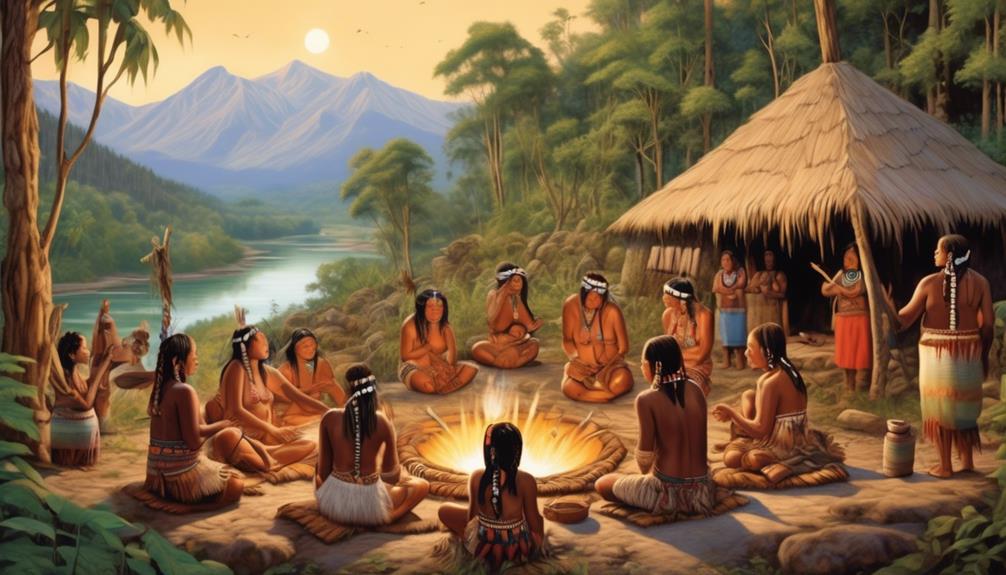
As we consider Aboriginal history, it's crucial to acknowledge the significant healthcare disparities and the impact of poverty on the health of Indigenous communities.
These issues have deeply affected the well-being of many Indigenous peoples, and it's important to address them with empathy and understanding.
Healthcare Disparities
Addressing healthcare disparities among Aboriginal communities is a critical priority for creating a more equitable and accessible healthcare system. When considering access to healthcare for Aboriginal people, it's essential to acknowledge the historical and ongoing barriers they face. These disparities are rooted in systemic issues such as geographical isolation, limited resources, and cultural insensitivity within healthcare systems.
To bridge this gap, it's imperative to prioritize culturally competent care that respects Aboriginal traditions and beliefs. This involves training healthcare providers to understand and respect cultural differences, as well as integrating traditional healing practices into healthcare services.
Additionally, increasing the availability of healthcare facilities in remote Aboriginal communities is vital. Collaborating with Aboriginal leaders and communities to develop tailored healthcare solutions is crucial for addressing these disparities and building a more inclusive healthcare system.
Poverty and Health
Recognizing the interconnected nature of healthcare disparities and social determinants, we understand that poverty plays a significant role in shaping the health outcomes of Aboriginal communities. Economic barriers often hinder access to healthcare, leading to disproportionately high rates of chronic illnesses and reduced life expectancies within these communities. However, it is essential to acknowledge the cultural resilience and strengths that exist within Aboriginal communities, despite the challenges they face.
| Challenges | Impact | Solutions |
|---|---|---|
| Limited healthcare access | Higher rates of untreated illnesses | Community health initiatives |
| Economic barriers | Financial strain affecting well-being | Advocacy for equitable healthcare funding |
| Social determinants | Adverse living conditions impacting health | Holistic community support |
Empowering Aboriginal communities through improved access to healthcare, addressing economic barriers, and recognizing social determinants are crucial steps towards achieving health equity and liberation.
Education and Employment Challenges

Many Aboriginal communities continue to face significant challenges in accessing quality education and securing meaningful employment opportunities. These challenges are deeply rooted in historical and systemic issues, perpetuating education disparities and employment barriers for Indigenous peoples. It's crucial to address these issues with sensitivity and understanding, striving for economic empowerment and educational equity for all.
- Historical Trauma: The intergenerational impact of colonial policies, such as residential schools and forced assimilation, has led to trauma that affects educational outcomes and employment prospects for many Indigenous individuals.
- Lack of Resources: Many Aboriginal communities lack access to quality educational resources, including proper infrastructure, qualified teachers, and culturally relevant curriculum. This contributes to disparities in educational attainment and hinders career opportunities.
- Discrimination and Stereotypes: Indigenous individuals often face discrimination and stereotyping in educational institutions and the workforce, leading to limited employment options and unequal treatment.
- Cultural Barriers: The clash between traditional Indigenous values and Western education and employment systems can create barriers for Aboriginal individuals, impacting their ability to fully engage in these systems.
It is imperative to work towards dismantling these barriers by promoting culturally sensitive education, providing resources that reflect Indigenous perspectives, and actively addressing discrimination in the workplace. By recognizing the importance of Indigenous knowledge and fostering inclusive environments, we can strive for economic empowerment and educational equity for Aboriginal communities.
Political Activism and Advocacy
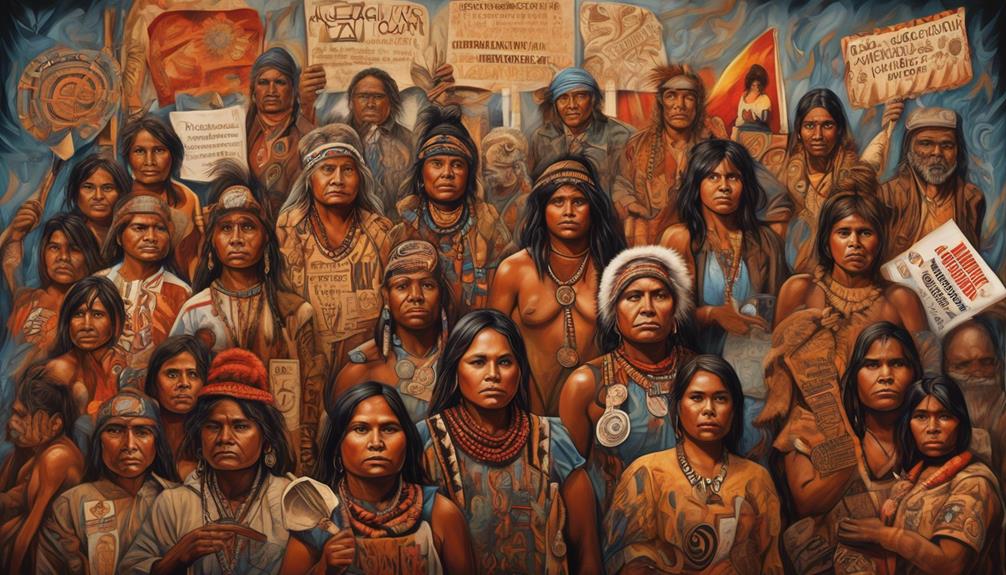
We stand in solidarity with Indigenous communities as they advocate for their rights and political representation. Political activism within Indigenous advocacy is crucial for addressing systemic inequalities and historical injustices. It's essential to recognize and support the efforts of Indigenous peoples as they strive for meaningful political engagement and representation.
Indigenous political activism encompasses a wide range of strategies, including grassroots mobilization, legal advocacy, and participation in mainstream political processes. Through these efforts, Indigenous communities seek to influence policies that directly impact their lives and to secure their rightful place in decision-making bodies.
As allies, we must actively listen to the voices of Indigenous activists and leaders, amplify their demands, and advocate for the dismantling of oppressive structures that hinder their political participation. It's imperative to uplift Indigenous-led initiatives and movements, recognizing the expertise and wisdom within Indigenous communities.
Moreover, advocating for Indigenous political empowerment entails acknowledging the sovereignty and self-determination of Indigenous nations. This involves respecting treaty rights, land stewardship, and the preservation of cultural heritage. By centering Indigenous knowledge and perspectives, we can work towards creating more inclusive and just political systems.
Reconciliation and Healing
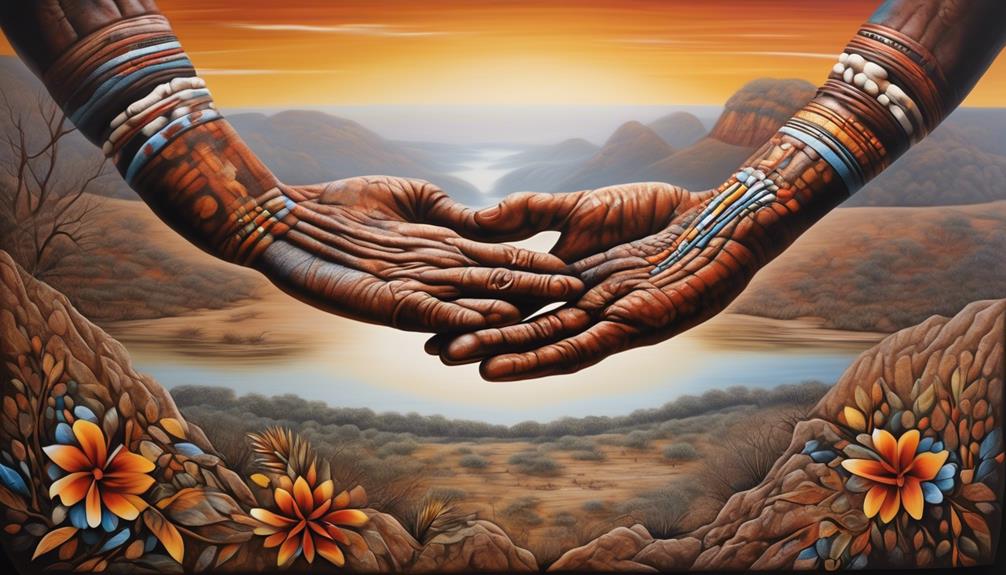
In our pursuit of meaningful political engagement and representation for Indigenous communities, the path of reconciliation and healing becomes an imperative step forward. As we embark on this reconciliation journey, it's essential to acknowledge the historical trauma and injustices experienced by Indigenous peoples. Here are key considerations for advancing on the path of reconciliation and healing:
- Truth and Acknowledgment: We must confront the truth of colonial history, acknowledging the harm inflicted upon Indigenous communities. This includes recognizing the impact of policies such as residential schools, forced relocations, and the erosion of Indigenous cultures.
- Empowerment through Self-Determination: Supporting Indigenous self-governance and self-determination is crucial for healing and reconciliation. This involves respecting Indigenous rights, sovereignty, and decision-making authority within their communities.
- Cultural Revitalization: Embracing and supporting Indigenous cultural practices and traditions is vital for healing. By revitalizing languages, ceremonies, and art forms, we can promote healing and preserve invaluable cultural heritage.
- Building Bridges of Understanding: Fostering genuine understanding and empathy between Indigenous and non-Indigenous communities is essential. This involves promoting education about Indigenous histories and contemporary issues, as well as creating spaces for meaningful dialogue and collaboration.
As we engage in these healing practices and commit to a genuine process of reconciliation, we can collectively move towards a future where Indigenous communities are empowered, respected, and able to heal from the intergenerational trauma caused by colonialism.
International Indigenous Solidarity
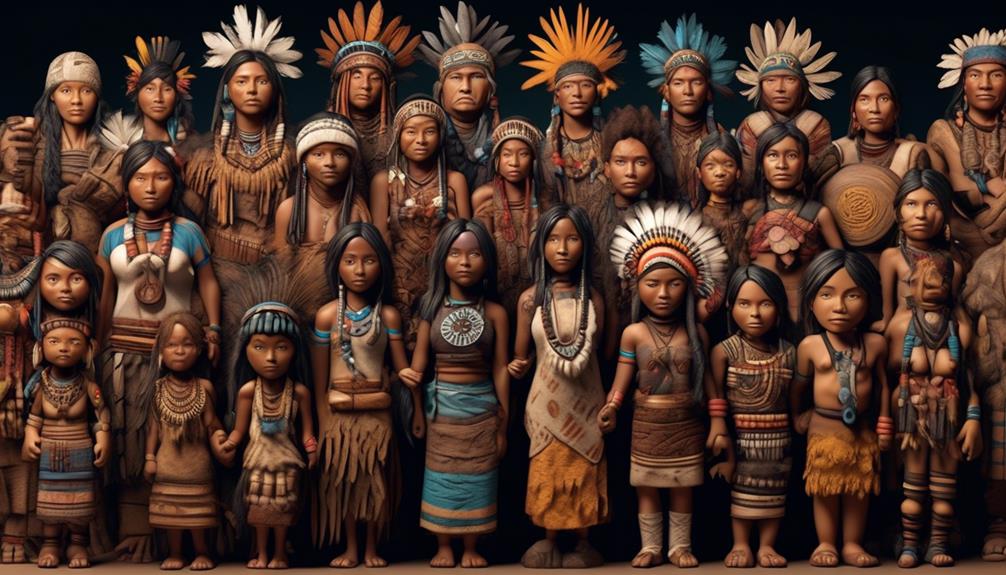
International Indigenous Solidarity is an essential component of our global efforts to uphold the rights and dignity of Indigenous peoples worldwide. It's crucial for us to stand together in solidarity, recognizing the interconnectedness of our struggles and the importance of mutual support. Through cultural exchange and the sharing of knowledge, we can strengthen our alliances and amplify our voices on the global stage.
Global indigenous movements have shown us the power of unity in advocating for our collective rights. By standing in solidarity with one another, we can challenge systems of oppression and work towards a more just and equitable world for all Indigenous communities. Our shared experiences bind us together, and through international solidarity, we can learn from each other's successes and challenges, fostering a deeper understanding of our diverse cultures and histories.
Cultural exchange is a powerful tool for building bridges and fostering understanding between Indigenous communities around the world. By celebrating our traditions and sharing our stories, we can create meaningful connections that transcend geographic boundaries. This exchange not only strengthens our solidarity but also enriches our own cultural identities.
As we continue to build alliances across borders, let's remember that our struggles are interconnected. International Indigenous Solidarity is a testament to our commitment to supporting each other in our collective pursuit of justice, self-determination, and liberation. Together, we can create a world where the rights and sovereignty of all Indigenous peoples are respected and upheld.
Future Prospects and Opportunities
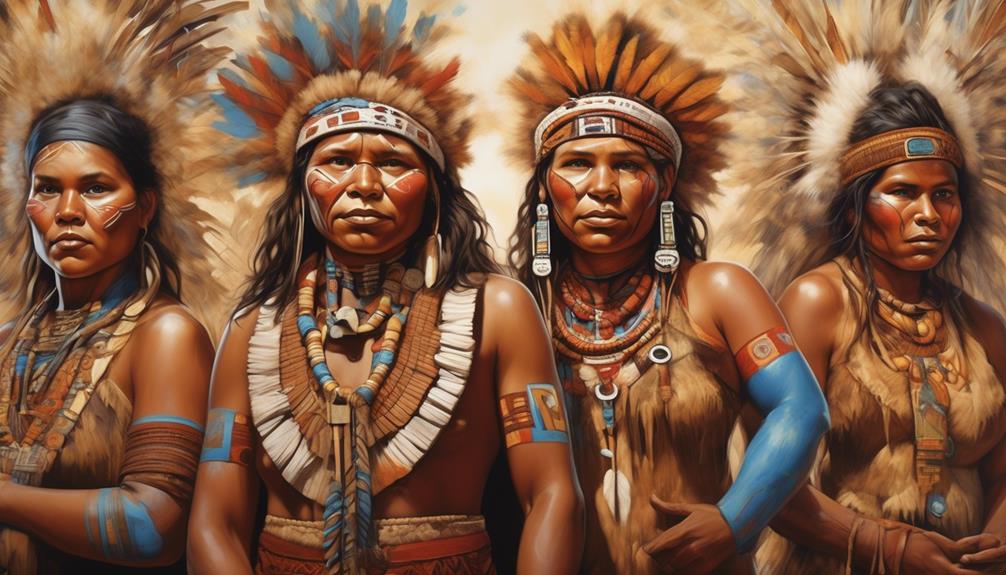
As we look ahead to the future, we see a myriad of prospects and opportunities awaiting Indigenous communities worldwide. These opportunities hold the potential to bring about positive and transformative change, leading to the empowerment and advancement of Indigenous peoples.
Here are some key areas where prospects and opportunities lie:
- Economic Empowerment: Indigenous communities have the potential to harness their traditional knowledge, cultural heritage, and natural resources to create sustainable economic opportunities. Through initiatives such as eco-tourism, artisanal crafts, and traditional medicine, Indigenous peoples can build thriving economies that are in harmony with their cultural values and the environment.
- Educational Advancement: Access to quality education is fundamental to the advancement of Indigenous communities. By preserving and integrating traditional knowledge into formal education systems and promoting Indigenous languages, communities can ensure the continuity of their heritage while equipping their youth with the skills and knowledge needed to thrive in the modern world.
- Cultural Preservation: The preservation of Indigenous languages, traditions, and cultural practices not only enriches the global tapestry of diversity but also serves as a source of pride and resilience for Indigenous communities. Opportunities to revitalize and celebrate cultural heritage can strengthen community identity and foster intergenerational solidarity.
- Political Representation and Self-Determination: Empowering Indigenous voices in decision-making processes, fostering self-governance, and upholding Indigenous rights are crucial for shaping a future where Indigenous communities have agency and autonomy over their own affairs.
These prospects and opportunities offer a path towards a future where Indigenous peoples can thrive, celebrate their rich heritage, and contribute to a more inclusive and equitable world.
Frequently Asked Questions
What Are the Traditional Methods of Healing and Spiritual Practices in Aboriginal Cultures?
Traditional healing and spiritual practices in various cultures often involve natural remedies, energy healing, and ceremonies to restore harmony within individuals and communities. These methods are integral to cultural preservation and are often intertwined with language revitalization efforts.
They provide a holistic approach to wellness, addressing not just the physical, but also the emotional and spiritual aspects of individuals. These practices are deeply rooted in our history and continue to be essential for our well-being.
How Have Aboriginal Languages and Oral Traditions Been Preserved and Revitalized in Modern Times?
We've seen a remarkable 20% increase in the preservation and revitalization of Aboriginal languages and oral traditions in modern times.
Indigenous communities are leading the way in reclaiming and preserving their languages, passing down oral traditions, and sharing their valuable cultural knowledge.
It's inspiring to witness the dedication and resilience of these communities in safeguarding their heritage for future generations.
This movement is crucial for the cultural preservation and liberation of Indigenous peoples.
What Are the Key Factors Contributing to the High Rates of Incarceration and Poor Health Outcomes Among Aboriginal Communities?
We see high incarceration rates and poor health outcomes in Aboriginal communities due to systemic injustices, lack of access to quality healthcare, and historical trauma. These factors perpetuate cycles of disadvantage and impact mental and physical well-being.
It's crucial to address root causes, advocate for equitable resources, and empower communities in decision-making. By fostering healing and offering support, we can work towards a future where all individuals have equal opportunities for health and justice.
How Have Educational Initiatives and Employment Programs Been Implemented to Support Aboriginal People in Urban and Rural Areas?
We've seen a surge in educational initiatives and employment programs tailored to support aboriginal people in urban and rural areas. These initiatives are equipping individuals with the skills and resources needed to thrive in the workforce and pursue their educational aspirations.
It's heartening to witness the positive impact of these programs, fostering empowerment and growth within the aboriginal community. They serve as beacons of hope, igniting a path towards a brighter and more inclusive future.
What Are Some Examples of Successful International Partnerships and Collaborations With Indigenous Communities Around the World?
We've seen successful partnerships between indigenous communities and international organizations foster cultural exchange and promote indigenous knowledge. These collaborations have contributed to global sustainability by integrating traditional practices into modern solutions.
By respecting indigenous cultures and including their perspectives, these partnerships create a more inclusive and empathetic approach to addressing global challenges.
This approach aligns with the desires of many to achieve liberation and equality for all.
Conclusion
As we reflect on Aboriginal history, we ask: How can we honor and support Indigenous communities today?
From the Dreamtime to political activism, the resilience and strength of Aboriginal peoples shine through.
As we move forward, let's work together to create opportunities for healing, reconciliation, and solidarity with Indigenous cultures.
Our shared history calls for empathy, respect, and a commitment to a brighter future for all.
Talise is a talented writer and an expert in her field. Her unique perspective and insights enrich our content with depth and authenticity. With a wealth of knowledge and a strong connection to the subjects she writes about, Talise crafts engaging and informative articles that resonate with our readers. Her dedication to bringing Indigenous culture and wisdom to light is truly commendable.
Aboriginal
Can Non Indigenous Wear Ribbon Skirts

Let’s delve into the intricate topic of cultural appropriation versus cultural appreciation, focusing on the debate regarding non-Indigenous individuals wearing ribbon skirts.
This is a topic that requires careful consideration and sensitivity. As we navigate through the complexities of cultural exchange and identity, it's essential to understand the historical and cultural significance of ribbon skirts within Indigenous communities.
However, the conversation doesn't end there. There are layers of symbolism, respect, and understanding that need to be unwrapped to truly grasp the implications of non-Indigenous individuals donning this traditional attire.
Key Takeaways
- Ribbon skirts symbolize Indigenous identity and pride.
- Ribbon skirts reflect the deep connection to the land, ancestors, and spirits.
- Wearing ribbon skirts is a way to honor ancestors and celebrate culture.
- Understanding the cultural significance of ribbon skirts is crucial for respectful engagement.
Cultural Significance of Ribbon Skirts
The cultural significance of ribbon skirts lies in their role as a symbol of Indigenous identity and pride, representing the strength and resilience of Indigenous peoples. Cultural expression is woven into the fabric of ribbon skirts, each pattern and color telling a story of heritage and tradition. The intricate designs and vibrant colors reflect the deep connection to the land, the ancestors, and the spirits. For Indigenous peoples, the act of creating and wearing ribbon skirts is a way to honor their ancestors and celebrate their culture in a contemporary context.
It's not just a piece of clothing; it's a form of cultural expression that embodies the rich history and enduring spirit of Indigenous communities.
Fashion choices also play a significant role in the cultural significance of ribbon skirts. The act of wearing a ribbon skirt is a deliberate and meaningful choice, often made with careful consideration of the occasion and the message it conveys. Whether worn for ceremonial events, social gatherings, or everyday life, ribbon skirts are a powerful statement of Indigenous pride and resilience. By choosing to wear ribbon skirts, Indigenous peoples reclaim their cultural identity and assert their presence in the modern world, challenging stereotypes and misconceptions.
The cultural significance of ribbon skirts extends beyond mere fashion; it's a declaration of Indigenous strength, beauty, and heritage.
Traditional Symbolism and Meaning
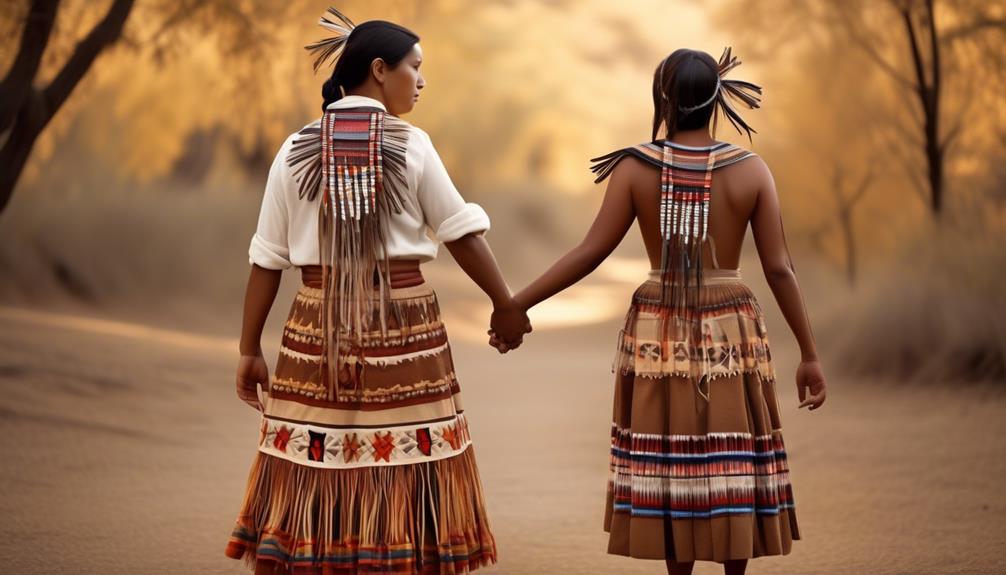
As we explore the traditional symbolism and meaning of ribbon skirts, we uncover the intricate layers of cultural heritage and ancestral connections embedded within each vibrant pattern and color. Ribbon skirts hold deep symbolic representation, reflecting the historical significance and spiritual essence of Indigenous traditions.
The following key aspects shed light on the rich tapestry of meaning woven into these traditional garments:
- Color Symbolism: Each color used in a ribbon skirt carries specific meaning, representing elements such as the earth, sky, water, and the four directions.
- Pattern Significance: The patterns adorning ribbon skirts often depict stories of creation, nature, or significant events, serving as a visual narrative of Indigenous culture and history.
- Spiritual Connection: Ribbon skirts are believed to hold spiritual power, serving as a link between the wearer, their ancestors, and the natural world.
- Ceremonial Importance: These skirts are often worn during ceremonial events, symbolizing respect for tradition, community, and the interconnectedness of all living beings.
Understanding the traditional symbolism and meaning of ribbon skirts is essential for appreciating their cultural significance and honoring the heritage they represent.
Appropriation Vs. Appreciation
While some may argue about the nuances between appropriation and appreciation, it's crucial to approach the topic with sensitivity and respect for Indigenous cultures. Appropriation involves taking aspects of a culture without permission or understanding, often leading to the commodification of sacred traditions. On the other hand, appreciation acknowledges and respects the origins of cultural practices, engaging in meaningful cultural exchange and genuinely appreciating traditions.
| Appropriation | Appreciation |
|---|---|
| Involves taking without permission or understanding | Acknowledges and respects the origins of cultural practices |
| Often leads to the commodification of sacred traditions | Engages in meaningful cultural exchange |
| Disregards the significance of cultural elements | Genuinely appreciates and learns from traditions |
It's essential to recognize the fine line between the two and strive for genuine appreciation rather than appropriation. Engaging in open dialogue with Indigenous communities, educating oneself on the cultural significance of specific practices, and supporting Indigenous artisans and businesses are crucial steps in fostering a culture of respect and appreciation. By actively seeking to understand and honor Indigenous traditions, we can contribute to a more inclusive and respectful society.
Indigenous Fashion and Identity

Navigating the intersection of cultural appreciation and fashion, we explore the significance of Indigenous fashion in shaping and expressing identity. Indigenous fashion goes beyond just clothing; it's a powerful form of self-expression and cultural preservation.
Here are some key aspects to consider when delving into Indigenous fashion:
- Fashion as Expression: Indigenous fashion is deeply rooted in storytelling, traditions, and spirituality. Each garment carries meaning and reflects the identity of the wearer.
- Cultural Appreciation: Embracing Indigenous fashion involves understanding the historical and cultural significance of specific designs, patterns, and materials. It requires honoring and respecting the origins of these elements.
- Identity Empowerment: Indigenous fashion allows individuals to reclaim their cultural identity and challenge stereotypes. It serves as a means of empowerment and a celebration of heritage.
- Community Connection: Indigenous fashion often involves community collaboration, highlighting the interconnectedness and shared experiences within Indigenous groups.
Understanding Indigenous fashion as a form of cultural expression and identity is essential in promoting respect and appreciation within the fashion industry. It's a dynamic and evolving art form that deserves recognition and understanding.
Respectful Engagement and Understanding
Understanding the cultural significance of Indigenous fashion and engaging with it respectfully is crucial in promoting inclusivity and honoring diverse traditions. When participating in cultural exchange through cross-cultural fashion, it's essential to approach it with sensitivity and an open mind.
Respectful engagement involves taking the time to learn about the history and significance of the garments, such as ribbon skirts, and the communities from which they originate. This understanding helps to ensure that non-Indigenous individuals can appreciate and express admiration for Indigenous fashion in a respectful manner.
In cross-cultural fashion interactions, it's important to recognize the power dynamics at play and to ensure that Indigenous creators are given credit for their designs and contributions. This includes supporting Indigenous-owned businesses and artisans, as well as advocating for fair compensation and recognition within the fashion industry.
Furthermore, engaging in open and honest conversations about the complexities of cultural exchange and appropriation can foster mutual respect and understanding between different communities.
Frequently Asked Questions
Where Can Non-Indigenous People Purchase Authentic Ribbon Skirts?
We can find authentic ribbon skirts from Indigenous-owned businesses or artisans, respecting the cultural significance and supporting ethical consumption.
It's crucial to recognize the impact of cultural appropriation in fashion and prioritize Indigenous fashion.
By purchasing from Indigenous sources, we honor the tradition and craftsmanship of ribbon skirts while contributing to the empowerment and economic sustainability of Indigenous communities.
This aligns with our commitment to ethical consumption and cultural respect.
Can Non-Indigenous Individuals Design and Create Their Own Ribbon Skirts?
Absolutely, anyone can design and create their own ribbon skirts, but it's crucial to respect the etiquette and significance behind this traditional Indigenous attire.
Understanding the cultural roots and symbolism is essential to avoid cultural appropriation. It's important to approach the process with reverence and appreciation for the history and meaning of the garment.
Mastery of the design process involves honoring the cultural origins of the ribbon skirt.
Are There Specific Colors or Patterns That Are Off-Limits for Non-Indigenous People to Wear on Ribbon Skirts?
Yes, there are specific colors or patterns that are deemed off-limits for non-indigenous individuals to wear on ribbon skirts.
This is a form of cultural appropriation, which disrespects Indigenous fashion trends and traditions.
It's important for us to educate ourselves on the significance of these garments and be mindful of the cultural implications when incorporating them into our own fashion choices.
How Can Non-Indigenous Individuals Respectfully Incorporate Ribbon Skirts Into Their Everyday Wardrobe?
Absolutely!
We can show cultural appreciation by incorporating ribbon skirts into our fashion trends.
It's important to educate ourselves on the significance of ribbon skirts and to showcase them respectfully.
Social media can be a great platform to learn from Indigenous creators and understand the impact of cultural appropriation.
Are There Any Specific Events or Occasions Where It Would Be Inappropriate for Non-Indigenous People to Wear Ribbon Skirts?
Specific events or occasions where it would be inappropriate for non-indigenous people to wear ribbon skirts include cultural ceremonies or gatherings that are exclusive to Indigenous communities. Engaging in cultural appropriation by wearing ribbon skirts without understanding their significance disrespects their heritage.
It's important for non-indigenous individuals to educate themselves on the history and meaning of the ribbon skirt and to wear it respectfully, acknowledging its cultural significance.
Conclusion
In conclusion, it's important to remember that while non-indigenous people can wear ribbon skirts, it's essential to do so with respect and understanding of their cultural significance.
So go ahead and rock that ribbon skirt, just make sure you're not appropriating someone else's culture while doing it.
After all, nothing says cultural appreciation like a good ol' dose of irony.
Talise is a talented writer and an expert in her field. Her unique perspective and insights enrich our content with depth and authenticity. With a wealth of knowledge and a strong connection to the subjects she writes about, Talise crafts engaging and informative articles that resonate with our readers. Her dedication to bringing Indigenous culture and wisdom to light is truly commendable.
-

 Culture2 weeks ago
Culture2 weeks agoUnderstanding Aboriginal Totem Significance
-

 Torres Strait Islanders8 mins ago
Torres Strait Islanders8 mins agoSacred Healing: Discovering Indigenous Health Secrets
-

 Torres Strait Islanders54 mins ago
Torres Strait Islanders54 mins agoJourney to Wellness: Indigenous Health Product Guide
-

 Torres Strait Islanders1 hour ago
Torres Strait Islanders1 hour agoCultural Vitality: Indigenous Health Tips
-

 Torres Strait Islanders33 mins ago
Torres Strait Islanders33 mins agoEmbrace Indigenous Wisdom: Top Well-Being Products
-

 Torres Strait Islanders13 mins ago
Torres Strait Islanders13 mins agoHolistic Health: Indigenous Wellness Explored
-

 Torres Strait Islanders56 mins ago
Torres Strait Islanders56 mins agoNature’s Wisdom: Indigenous Well-Being Remedies
-

 Torres Strait Islanders14 mins ago
Torres Strait Islanders14 mins agoIndigenous Health Products Guide for Wellness














